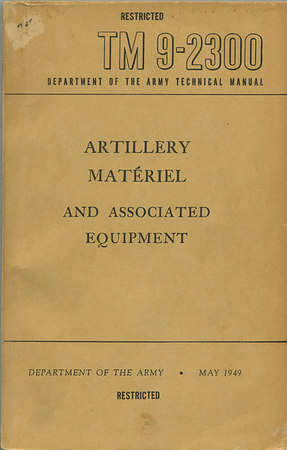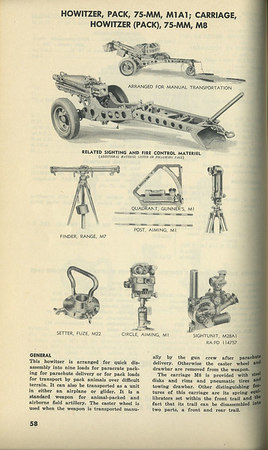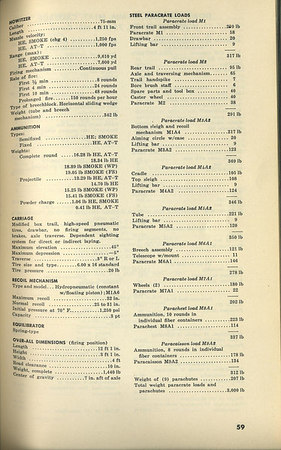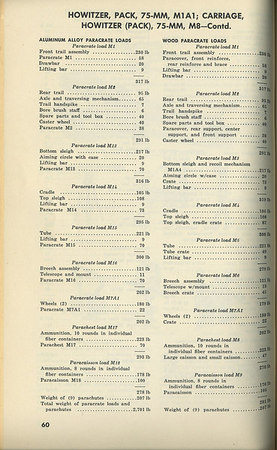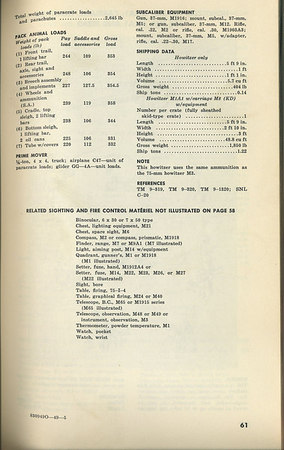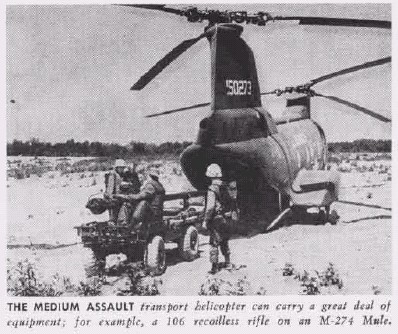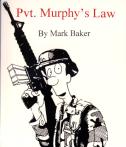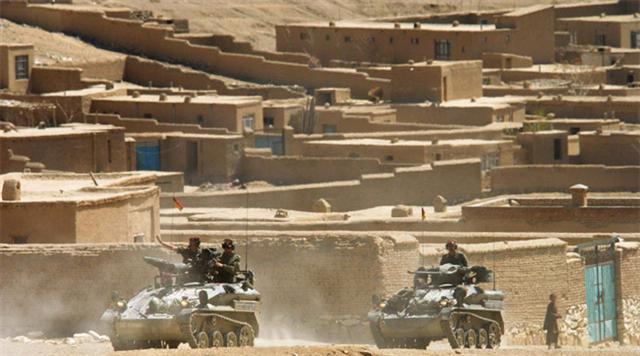
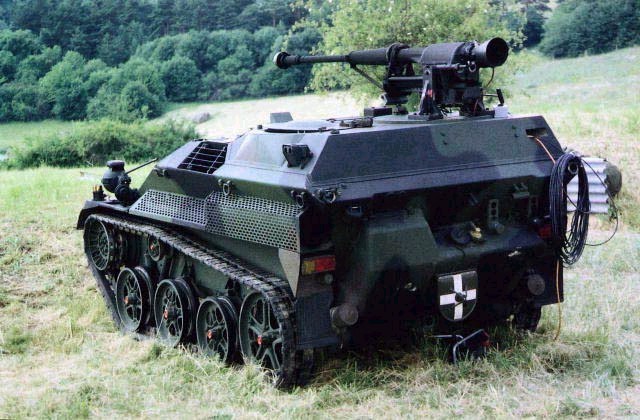
German Wiesel 1s light tankettes in Afghanistan; version with 30mm recoilless autocannon
Afghan villages are surrounded by THICK mud walls which absorb small-caliber Kinetic Energy (KE) bullets; even 12.7mm (.50 caliber) Heavy Machine Guns are ineffective. Thus, our smarter NATO Dutch, German, British and Canadian allies have sent tracked tanks into Afghanistan that shoot high explosive (HE) shells that can breach these walls if Taliban rebels try to hide behind them.
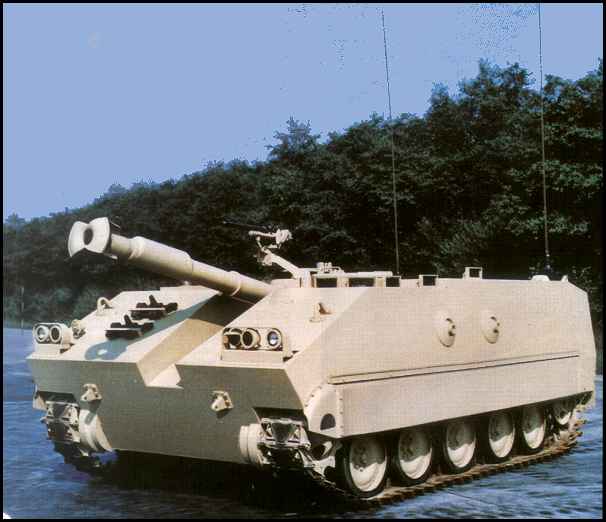
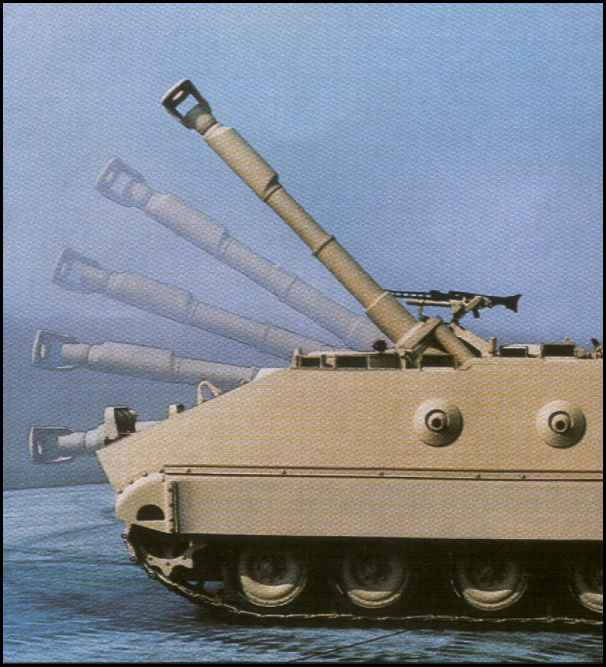
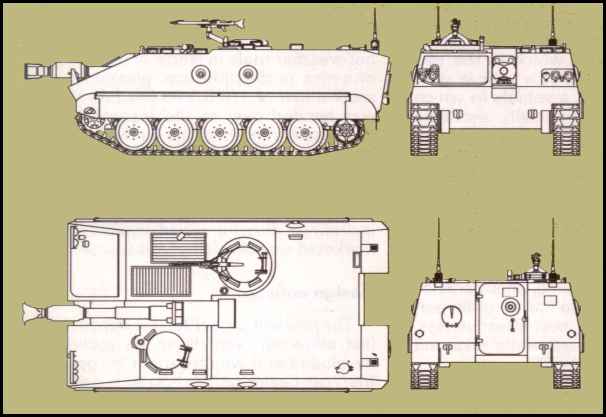
One simple way to get HE effects is to mount autocannon like the German Wiesels have; on top the standard 20mm cannon and above, the new recoilless 30mm cannon; all are available to retrofit to our plentiful M113 Gavins. Moreover, a turret-less STUG-type M113 Gavin could be made with a very large HE cannon to blast through Afghan strongpoints and be very well armored by avoiding turret weakness (high silhouette, junction vulnerability) and inefficiency (weight but no added protection) all in a maximum closed-terrain mobile vehicle. These would be C-130 Hercules airland and airdrop transportable.
 www.youtube.com/watch?v=ddnntGA8vEs
www.youtube.com/watch?v=ddnntGA8vEs
Another option is to reduce the size of the M113 into a "Mini-Gavin" to be an M50 Ontos or Wiesel tankette that is HELICOPTER-AIR-TRANSPORTABLE, too.
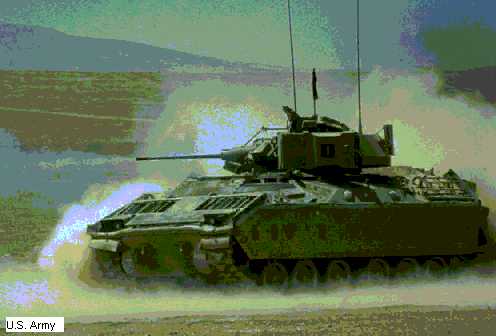
EXCLUSIVE! Iraq Combat video clips: what happens when you bring a rifle to a tank fight!
www.combatreform.org/ArmyBIGREDONEinfallujah.asf
 www.youtube.com/watch?v=xmliSaufRbs
www.youtube.com/watch?v=xmliSaufRbs
The video above shows how typical Middle Eastern building can suck up small caliber bullets easily without ill-effect. Notice even AT4 84mm rockets, expensive Javelin ATGMs, don't render that much of a "bang".
Note the ability of tracked AFVs to venture out and get into a firing position where their 25mm autocannon and 120mm large caliber cannon MIGHT have an effect on known enemies seen even for a second in a building. We should have had our M109A6 Paladin SPHs pitch in, too!
You can draw many lessons here, to include whether aircraft bombing and leveling an entire building minutes and hours after an enemy is spotted (and long gone) is helpful, either.
LTC John Barker, U.S. Army, former XO of 3rd/73rd Armor says:
Robert W. Black, in his book, Rangers in World War II said the following about the disastrous Dieppe Raid where commandos assaulted fortified positions with little fire support other than what they carried in their hands;
Was on this internet address: www.acq.osd.mil/at/losat2.htm as an Official U.S. Army ACTD web site statement until it became politically incorrect and was removed to shield the bureaucracy from justified criticism.
WHAT DO WE DO? WE GET RID OF ALMOST EVERY HEAVY DIRECT-FIRE SYSTEM WE HAVE!
WHAT RIGHT LOOKS LIKE: 1960s Firepower Demo Puts Us to Shame Today
M728 Combat Engineer Vehicle (CEV) & Friends
CPT Frank Sherman, U.S. Army "C" Company Commander of 3rd/73rd Armor who parachute airdropped in his light tanks to support the 82nd Airborne Division writes; "Our first encounter with the Panamanian Defense Force (PDF) occurred as the infantrymen of 1st Battalion, 504th PIR were establishing a supply route from Toucumen International Airport to their initial objective of Tinajitas. The convoy had only moved a few kilometers when it stopped to clear a roadblock located on a bridge. As the Sheridansmoved to the edge of the highway to support the infantry, SSG Troxell, the lead tank commander, called me on the radio and stated, 'This is hell of a place for an obstacle, buildings all around and no cover. It looks like swamps on both sides of the road'. As the infantry dismounted and began to execute their obstacle drill, they began receiving automatic weapons fire from the buildings no more than 50 meters away. The lead tank commander opened up with .50 caliber fire as the wing tank commander screamed to his gunner to identify the threat. A moment later, SFC Freeman, 1st Platoon sergeant, yelled, 'I got 'em, concrete building, second floor, fourth window from the right'...He fired a 152mm heat round at the target, ripping through the room, collapsing the right side of the building. The enemy fire stopped and the infantry finished clearing the roadblock..."
"The Sheridan with its 152mm main gun was the near-perfect light infantry support vehicle. It could swim. It had thermal sights. It had long-range armor destruction capability equal to or greater than a Hellfire missile (check your PH/PK classified data!) The Shillelagh with its 152mm HEAT round could blow a hole in a reinforced concrete wall large enough for infantry soldiers to walk through side by side. An infantry leader could use the external phone, it boasted a flechette' round that could blast 17,000 one-inch nails into enemy infantry as close support, and oh by the way, you could parachute it into combat for those nasty 'forced entry' missions typically laid at the feet of the Paratroopers of the "Devils in Baggy Pants", "Panthers" and "Falcons" of the 82nd....."
Quotes from U.S. Army Armor magazine, January-February 1997, March-April 1990, page 15.
"68% of the 4,963 Canadian troops were casualties and 913 were killed outright.... On August 19, 1942, the Canadians did all that flesh could do against fire, but has been proven on battlefield after battlefield against an aroused, entrenched enemy, COURAGE IS NOT A SUBSTITUTE FOR FIRE SUPPORT..."
"Within this evolutionary climate, fiscal realities and the aging of existing systems have resulted in a significant gap in our forced/early entry capabilities. The deactivation of the 3rd Battalion, 73rd Armor, coupled with the termination of the Armored Gun System (AGS), has created a critical need for enhanced direct fire assault support and anti-armor capabilities for forced/early entry forces".
 www.youtube.com/watch?v=IuqtSncas8o
www.youtube.com/watch?v=IuqtSncas8o
M728 CEV bulldozing Log Obstacles
 www.youtube.com/watch?v=FPR6jxZlia8
www.youtube.com/watch?v=FPR6jxZlia8
Despite urban combat realities, we've mothballed our Iowa Class battleships, retired the M728 Combat Engineer Vehicle (CEV) with 165mm demolition gun, withdrawn the M551 Sheridans to NTC as training aids, cancelled the M8 Ridgway Armored Gun System, thrown M113s into the sea to feed fish leaving us with the only BIG GUN to win a direct-fire urban fight on a 70-ton Abrams tank that is sometimes too big to fit into narrow Third World Country streets and too heavy to fly in large numbers or airdrop to accompany our light troops who are the first-to-fight. Even if M1s can be delivered in time, their turbine engine exhaust prevents infantry from following behind to use the tank as moving cover in a city fight or to tow trailers with more main gun ammunition and/or supplies for infantry. "Passing the buck" to other combat arms/services does not work.
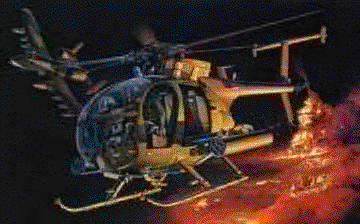
Captain James Lechner was a Fire Support Officer (FSO) with 3rd Battalion, 75th Rangers in Somalia and wounded in the tragic October 3-4, 1993 battle with Aideed's gunmen that claimed the lives of many Americans due primarily to a lack of armored vehicle fire support:
"...the U.S. Air Force can only safely and effectively provide CAS to within a very limited proximity of friendly troops. The limitations of CAS with most fixed-wing aircraft and ordnance provides the enemy a relatively large zone in which to operate unhindered by the potentially devastating effects of aviation assets...An Air Force TACP writes in to a www.news group:
"Capt. Gary Jinks and I were the AF targeting officers assigned to Just Cause. In one of our first meetings the lack of arty support was a prime concern. Gary and I suggested that we get a battle wagon off each coast and that would allow us to range all of the primary targets. The response from an Airborne Army full bull [Colonel] was 'This is an Army show, the Navy won't play.'
Well, they did, and lost someone, and we never did get the arty support required. The AC-130's did a good job, but had point-detonating fuzes instead of the delayed fuzes required for the cement buildings in Panama, another point raised by Gary and myself.
Having said that, the worker bees got along well and did what had to be done. The problems were at the upper levels.
And yes, it was a real war. I was at Ft. Clayton the nights the PDF dropped mortar rounds on us. No fun".
Nor can indirect fire from artillery or naval guns be counted on to work even if they are available:
IN 0531 Combat in built-up areas states:
"Securing and/or clearing a built-up area is very manpower-intensive. A city block in Panama City often included 50 buildings, many of them multiple storied, to include high rises. Most buildings were constructed of concrete reinforced with rebar."
"The direct-fire system is the most effective fire support in built-up areas. Once a target can be located in a building, one or two direct-fire rounds can accomplish what entire salvos of indirect-fire artillery cannot. Direct fire support is key to success in fighting in built-up areas..."
U.S. Army Lesson Learned: Operation Just Cause Building Clearing
"The 25mm gun produces its best urban target results when fired perpendicular to a hard surface (zero obliquity). In combat in built-up areas however, finding a covered firing position permitting low obliquity firing is unlikely unless the streets and gaps between buildings are wide. Most shots impact the target at an angle which normally reduces penetration. With the armor-piercing, discarding sabot with tracer (APDS-T) round, an angle of obliquity of up to 20 degrees can actually improve breaching. The rounds tend to dislodge more wall material for each shot, but do not penetrate as deeply into the structure"---IN 0531 Combat in built-up areas"Reinforced concrete walls which are 12 to 20 inches thick, present problems for the 25mm gun when trying to create breech holes. It is relatively easy to penetrate, fracture, and clear away the concrete, but the reinforcing rods remain in place" 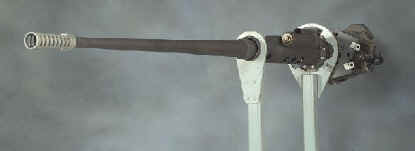
"From a historical perspective you are absolutely right about the need for large-caliber guns using direct-fire in urban fighting. The Germans and the Russians considered it imperative to have big guns in street fighting. In Patton's book War as I Knew It he describes using 155mm SP guns firing one round at a very obtuse angle to breach all the buildings on one side of the street. A 25mm gun would be of little value. While visiting a cemetery in Luxembourg I met an infantrymen from 3rd Army. I was reading the book at the time and over a beer or two he told me exactly how it was done.
They would fire the gun on the right side of the street and clear the first house. He related how many times it would kill or wound the majority of the defenders in the lower level of the buildings. Then you put a Bazooka team in the back yard of the first house cleared and slowly work up the block using the backyards and the hole created by the 155.
One point he emphasized over and over. Even tracked vehicles could not move down the streets because of road blocks. The guns had to have engineer support to move though the backyards and alleys. Usually when the attack on a block began the guns would reposition themselves to fire on the left side of the street as the attack progressed. All commo was with wire."
Emery Nelson
Yet we're spending BILLIONS$ on a fast water swimming assault vehicle and putting .50 caliber "pop guns" on poorly armored 8x8 LAV trucks. Only tracked M2/3 Bradley IFVs in heavy units have 25mm guns! Thus, all Light, Airborne and marine troops will have only "garden hose" area suppressive weapons--less than 25mm---or low-velocity 40mm and .50 caliber HMGs mounted on vulnerable wheeled HMMWVs---Somalia's debacle all over again. Our men pinned down by superior numbers of enemies firing bargain-basement AKM automatic weapons and RPG fire plus their own 30mm AGS-17 and CHICOM W-87 man-portable autogrenade launchers behind urban cover are not going to be able to stand up in the open and shoulder fire bulky rockets and missiles (AT4/M72A2 LAWs, 83mm SMAWs, M67 90mm and M3 Carl Gustav RAAWS 84mm RRs, Dragon, Javelin, Predator-Broadsword MPIM, ATGMs) to regain fire superiority. We're fighting at best "even" and more likely losing.
So even if our "Heavy" 2D forces can arrive before the enemy has escaped as he recently did in Fallujah they'll have 25mm "garden hoses", and a handful of 70-ton immobile tanks to do all the bunker-busting, building clearing once done by the now retired M728 CEV, AND kill any enemy tanks that show up with a mere 40 main gun rounds onboard? Not to mention we no longer have flame-thrower tanks. "That dog won't hunt". We need a lot more direct-fire support than what we have now to win cityfights.
WHERE HAS ALL OUR WW2 FIREPOWER GONE?: It All Begins With Fuzzy Thinking...
One of the ways the Army blunders is by using fuzzy requirements instead of looking at things clearly via generic reality. In the mid-1950s, the Army had two fuzzy requirements: a 10-ton airborne armored personnel carrier which became the incredibly successful M113 Gavin and a 4-ton requirement for a recon, 106mm recoilless rifle anti-tank and MEDEVAC litter carrier.
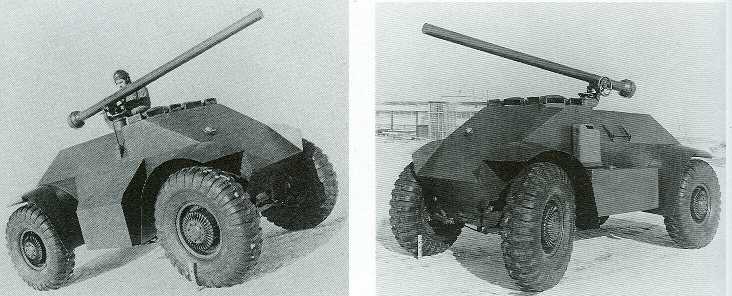
The End-State of the Humvee truck circa 1954
The wheeled T115 prototype was dismissed as not having cross-country mobility in favor of the tracked T114 which became the failed M114 built by General Motors who had little experience in designing successful armored combat vehicles. Had people been thinking in concrete terms, they should have realized the 10-ton APC could have been cut-down in size to be the smaller vehicle and saved the Army millions of dollars and improved war practice by sharing as many of the same components as possible. By the time FMC realized and made the cut-down M113 Gavin for recon (and roll-on/off from inside a CH-47 Chinook heavy lift helicopter) the Army was already committed to the M114 which failed miserably in Vietnam from a design flaw of having hull overhang in front of its tracks that would impale itself on the upper bank of a rice paddy trying to be crossed. This failure to develop and field a scout vehicle even though the much larger M113 Gavin was hugely successful even with extra volume in the back and a cut-down version was hugely successful in use by our NATO allies would have tragic consequences down the road as the XM800 program which needlessly started from scratch would fail leading to scout requirements superimposed onto the already bloated Bradley semi-replacement for the M113 Gavin. The current M3 Cavalry Fighting Vehicle (CFV) which the Army has 2,000 is far too large and noisy for scouting but it can take a hit and fight with its 25mm autocannon and TOW ATGM weaponry. The solution is and always has been to take M113 Gavins that are sound automotively from an all-terrain mobility perspective and logistically sound because 50% of the Army uses them to make scout vehicles not to slap more and more armor onto Humvee trucks morphing them into voila! the T115, or buying 8-wheeled T115s which is what the LAV-III/Stryker thinly armored truck is.
We could have bought French AMX-13 light tanks with 75mm to 105mm guns in the 1950s if the 106mm RR light tankettes were not sufficient perhaps because of recoilless backblast signature.
AMX-13
 www.youtube.com/watch?v=SJGe21it-vo
www.youtube.com/watch?v=SJGe21it-vo
The British in the aftermath of WW2 realized the need for a 8-ton light tank for recon and light infantry fire support that continues to kick ass today.
Scorpion Light Tank
 www.youtube.com/watch?v=PWqG4IYZNHw
www.youtube.com/watch?v=PWqG4IYZNHw
BYE BYE BIG GUNS, HELLO POP GUNS!
M132 Gavin Flamethrower
 www.youtube.com/watch?v=8pRihxvk4YY
www.youtube.com/watch?v=8pRihxvk4YY
M163 Vulcan
 www.youtube.com/watch?v=XHsFe1Abk2A
www.youtube.com/watch?v=XHsFe1Abk2A
M167 Vulcan Towed
 www.youtube.com/watch?v=tMWr3OY0xEM
www.youtube.com/watch?v=tMWr3OY0xEM
The Field Gun: the First Way to Horse and Man-Handle Big Guns to Battle

Camels towing field guns for the Russians in the 1945 Manchuria campaign.
Where is our Field Artillery? Recoil Guns or Recoilless Rifles, Rockets or Missiles?
Retired LTC Ranger Larry Altersitz is right that the recoil-dampened 75mm pack howitzer @ 1, 439 pounds is a monster to man-handle. Our 37mm AT gun was not much better.
http://ibiblio.org/hyperwar/USA/USA-P-Return/USA-P-Return-14.html
U.S. Army in World War 2: The War in the Pacific: Leyte: the Return to the Philippines, Chapter XIV, Measure of the Fighting notes:

"The 37mm. gun was an antitank weapon only occasionally employed by the 7th Division because there were few Japanese armored vehicles against which to use it. The excessive difficulty of manhandling it into a position from which fire could be delivered against Japanese pillboxes and machine guns rendered it ineffective for that purpose."
However, my point is that we have lost the skills and equipment to airdrop and move around heavy weapons for close support (field gun concept) dismounted by carts/wheels that we once had with folks like Darby's Rangers that could go 10 miles in 87 minutes towing their 81mm medium mortars on M3A4 Cole carts.
Today's U.S. light infantry drives around in Humvees and has no HE firepower apart from uber expensive TOW ATGMs; towed 105mm M119 versions of British light guns are back at the forward operating base (FOB) most of the time out of range to offer fire support--and certainly not there with maneuver units hunting down sub-national conflict (SNC) rebels to render on-scene, firepower that is precise. We call in too-fast, fighter-bomber air strikes then wonder why after killing innocent civilians that the rebellion grows against us?
In contrast, the 75mm pack howitzer could be delivered in 6 x pack-mule loads or 9 x paracontainer loads with 18 rounds of ammo dropped from a C-47 under the wing and from the door, linked together by a rope.

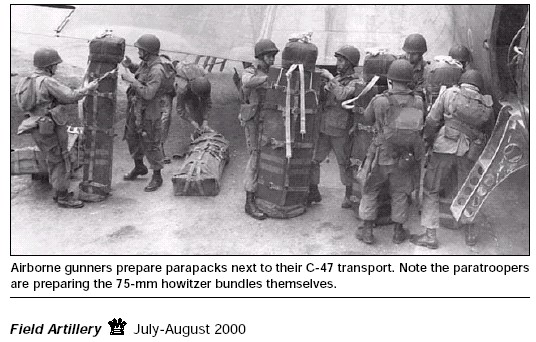
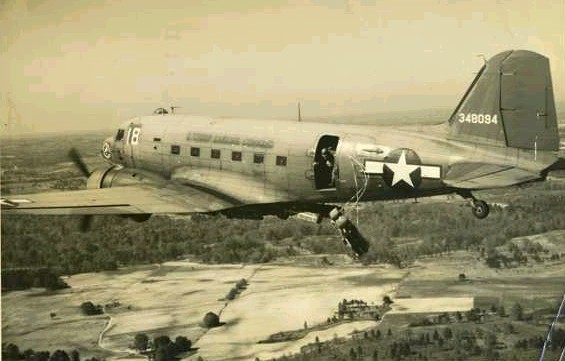

www.handcartz.smugmug.com/gallery/895456_53DPC#130702567_3GEh2
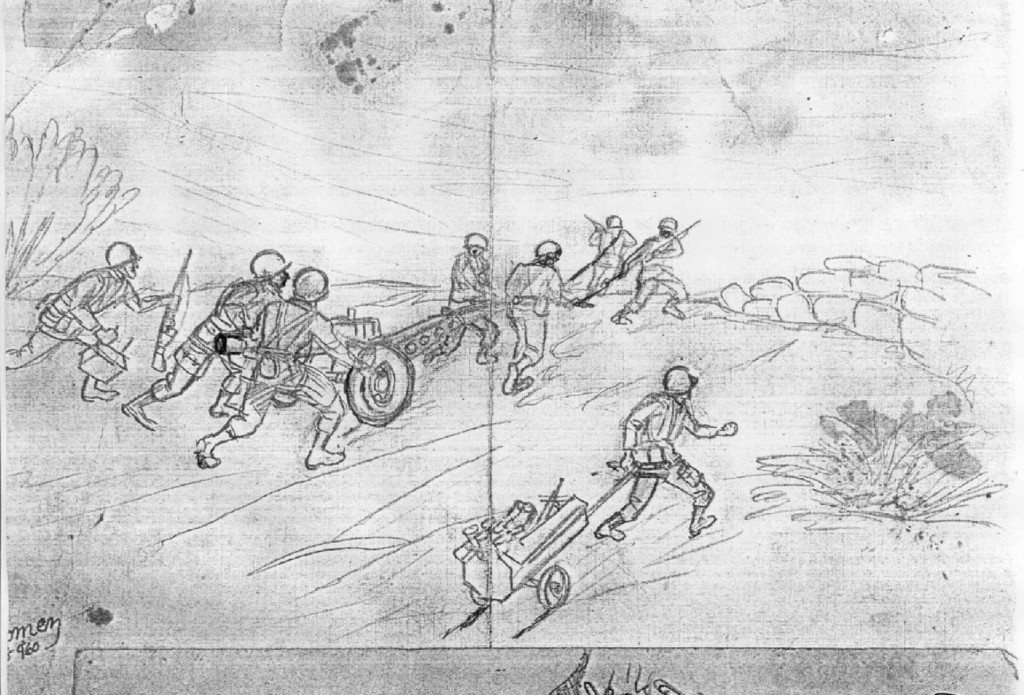
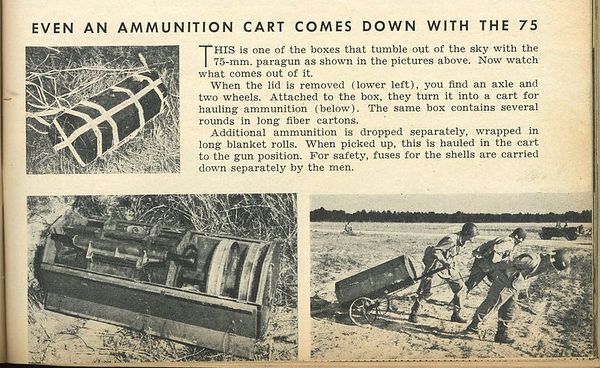
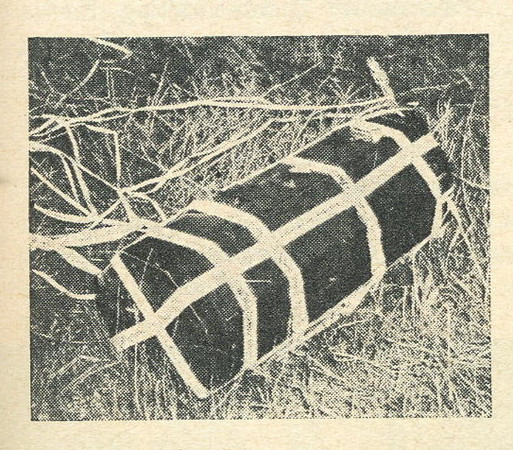
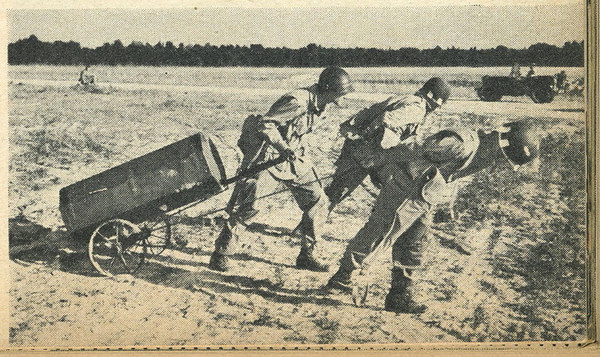
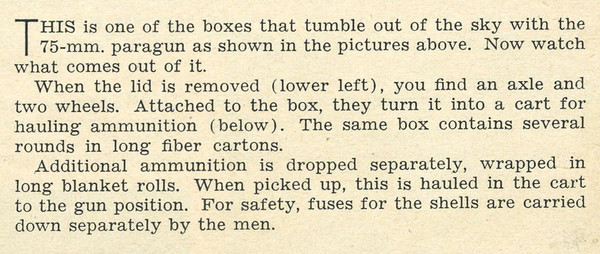
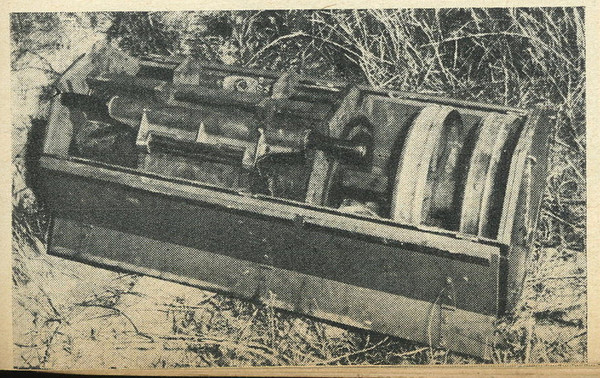
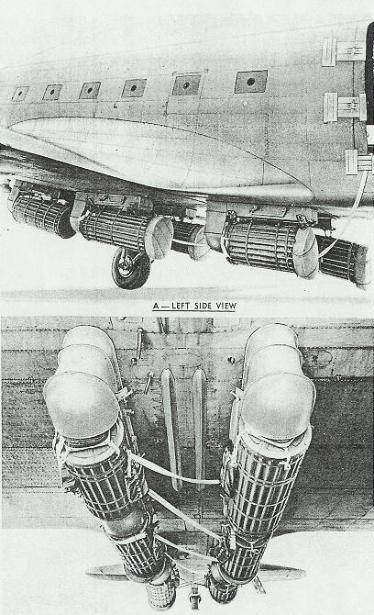
Gavin and his comrades got the idea of equipment containers made into carts from studying the German Airborne victory on Crete in 1941 though not being too dependant on them, by having each Paratrooper jumping in his own equipment using lowering line loads.
Darby's Rangers were annihilated when confronted by German tanks at Cisterna and could have used some 75mm pack howitzers despite them being a pain-in-the-ass to move around. Colonel Gavin's Paratroopers held off German Panzers on Biazza Ridge in Sicily because he insisted the direct-fire, pack 75mm howitzers be taken over General Ridgway's idea of just taking indirect fire, 81mm medium mortars whose unguided bombs would have been unable to direct-hit, fast-moving, armored tanks to knock them out. The Paratroopers would probably been over-run if we had gone with Ridgway's suggestion, but to his credit he went with his subordinate's idea and the victory was won. Today, "the boss is always right" and these non-professional, bureaucratic folks would have lost Biazza Ridge--as they are losing Iraq/Afghanistan today. A direct hit from a 75mm pack howitzer with 6, 400 meter range could penetrate 3.64 inches of steel armor to knock-out most tanks back in WW2 and even many today!
http://en.wikipedia.org/wiki/M116_howitzer
The gun fired fixed (HEAT M66) and semi-fixed ammunition, fitted with 75mm Cartridge Case M5A1 (type II) and (type I) accordingly. The propellant charge of semi-fixed ammunition consisted of base charge and three increments, forming four different charges, from 1 (the smallest) to 4 (the largest).[22]Why weren't 75mm pack howitzers mounted on tracked "Bren gun" universal carriers for Operation Market-Garden since they could have knocked out German light, medium and even heavy tanks?HEAT M66 Shell penetrated about 91mm of homogeneous armor at 0 degrees at any range.[23]
www.geocities.com/armorhistory
So you also have to question why Task Force Smith of the 24th Infantry Division in Korea wasn't equipped with 75mm pack howitzers (not the old M1897 French 75mm guns used on [http://en.wikipedia.org/wiki/M3_GMC] M3 gun-motor carriages and B-25H medium bombers that could barely penetrate 3 inches of armor) on M3 half-tracks for mobile firepower since a direct hit would knock out the North Korean's T34/85 medium tank's 65mm (2.6 inch thick) armor? Admittedly, a howitzer doesn't shoot with as flat a trajectory as a longer barreled gun, so its harder to point/shoot and hit targets like moving enemy tanks; but Gavin's men were able as were thousands of German STUG turretless tank crews with short-barrel 75mm guns who killed thousands of Russian and Allied tanks in WW2.
http://en.wikipedia.org/wiki/T-34
After WW2, light units like the Airborne and marines kept using 75mm pack howitzers. The USMC switched out the 75mm short-barrel howitzer for a 4.2" (107mm) heavy mortar to create a "Howtar".
www.mortarsinminiature.com/USM98.htm
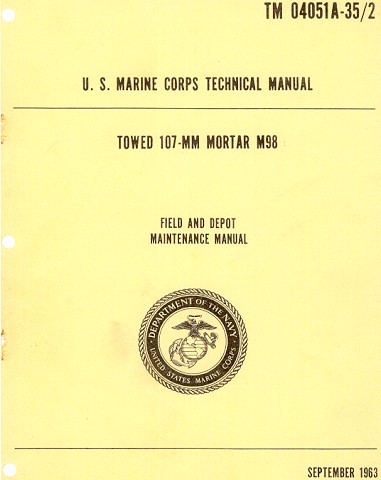
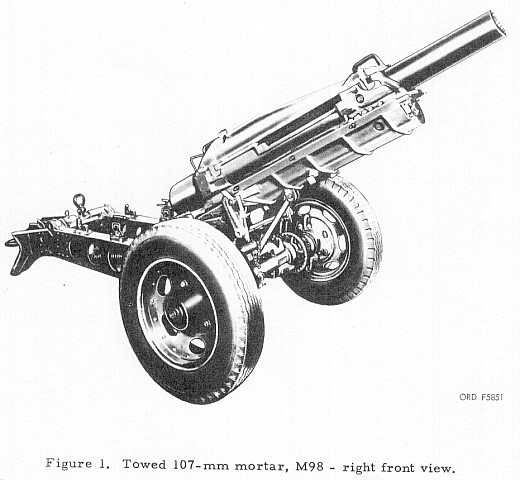
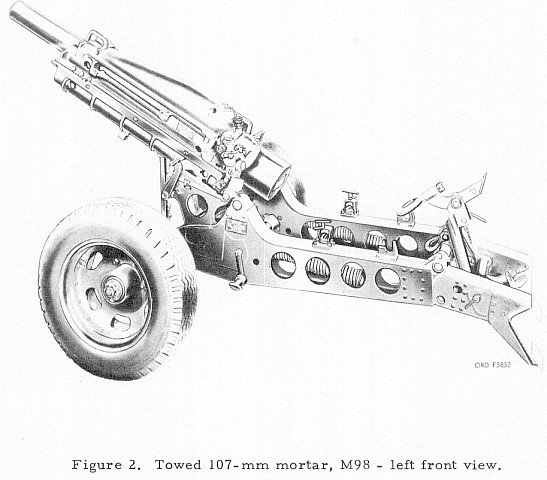
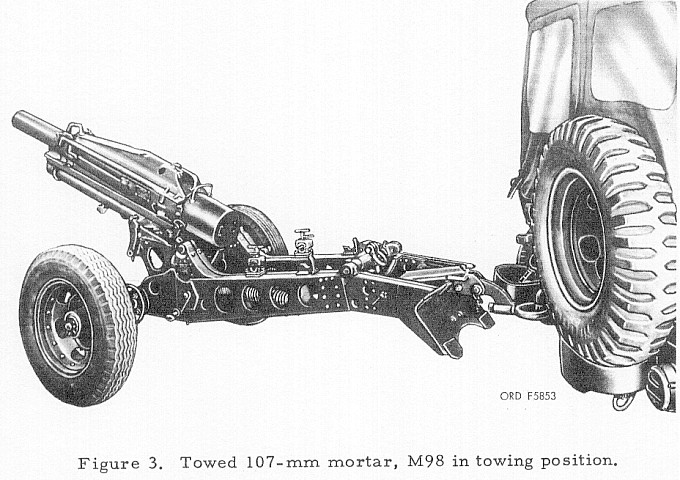
A Brief History:The benefit of having your heavy mortar on wheels with recoil dampening is that you can FIRE IMMEDIATELY and not have to stop and sink-in a base plate.During the early 1960's, the marine corps was looking to improve on and to consolidate their tactical requirements for Close Support Artillery (CSA). They also had the requirement to be a more mobile force with the new tactical air-mobility concept of vertical helicopter assaults that was fast becoming marine doctrine. With the marines still having the very popular 75mm Pack Howitzer of WWII fame as well as the fairly new M30 4.2-Inch (107mm) mortar in their inventory, it was decided to see if the concept of mating the 4.2" (107mm) tube to the howitzer's carriage would actually fit into this new requirement.
With various modifications to the howitzer's M3A3 (?) carriage, and the installation of the M99 Cannon in place of the 75mm howitzer to this carriage, this combination became known as the Model 98 HOWTAR. Trials of the HOWTAR proved out to be successful and it was officially accepted into USMC inventory in May of 1962. A battery of six guns would be assigned to each direct support artillery battalion in exchange for the "traditional" and labor-intensive M30 mortar.
Transporting the HOWTAR was accomplished by sling load (UH-34) and/or internally (CH-46, CH-53) by helicopters, pulled by 1/4 jeep or 3/4 ton and larger vehicles or could be disassembled to be carried by individual marines (1,289 pounds?). The ease of transporting the HOWTAR would prove to be invaluable during the 1960's.
Rivaling the 105mm M101 Howitzer in destructive power, and approximately one-half of the weight, the HOWTAR fired the slightly larger 107-mm (4.2") standard range of munitions. Range capabilities were greater for the 105-mm but, for the CSA work as originally intended for the Model 98, long range was not a necessity. The HOWTAR was intended to fire its rounds at a much higher angle.
Initially deployed with the marines during the Dominican Republic Crisis of 1965 and would also go on to serve with distinction during the Vietnam War, often operating in conjunction with the M30 4.2-Inch mortar. However, the HOWTAR's service life would be relatively short and by the end of the 1960's, it would be phased out of front-line service, only to be replaced by the M30 mortar that the HOWTAR was originally destined to replace. The HOWTAR would finish out it's final days in marine corps inventory as a ceremonial gun firing blank rounds and at least one is known to have been restored. This restoration now resides at the Marine Corps Museum, Quantico, Virginia.
Model 98 General Description:
The towed 107mm mortar, M98 is a mobile artillery piece. It is manually operated and drop-fired. The recoil mechanism is hydro-pneumatic type, having a floating piston and an adjustable pneumatic respirator. The mortar is used for indirect fire and can be elevated to high angles to deliver plunging fire on target.
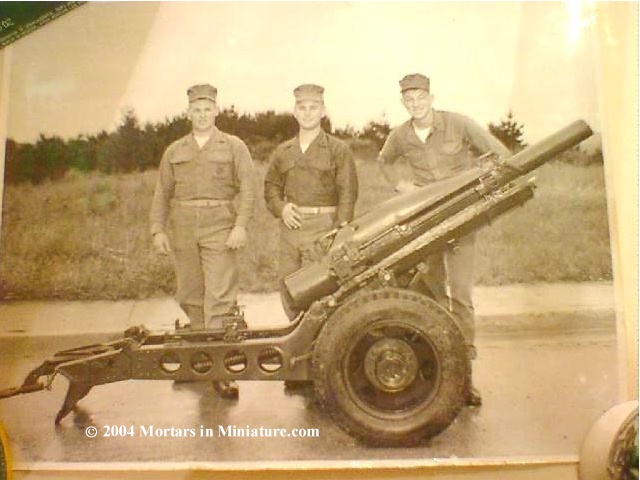
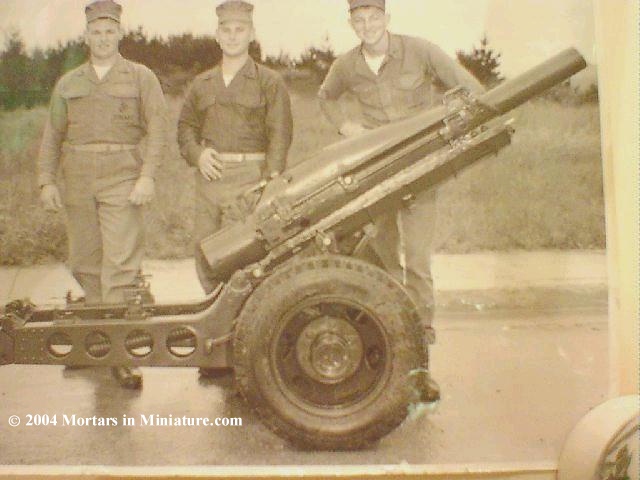
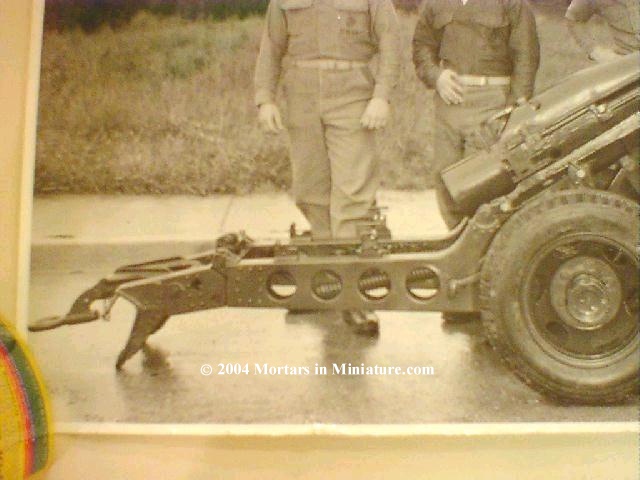
Alistair J. Crerar (r) February 1966 - Okinawa
(For more on Alistair J. Crerar, and additional photos of the HOWTAR, please visit the Honor Roll Page 2)
A. Data pertaining to 107-mm Mortar Cannon M99:
This weapon is composed of the 107-mm mortar cannon M99 with recoil mechanism M38 mounted on carriage M33.
1) General:
Caliber: 107mm (4.2")
Length (tube and base cap): 70-15/16 in.
Weight (tube and base cap): 245 lb.
Rifling: 24 Lands and Grooves, graduated right-hand twist.
Range (Maximum): 5,500 meters (6,015 yds.)2) Performance (average for new mortar):
Type of ammunition: Fused and semi-fixed, complete round.
Weight of projectile (approximate): 25 lb.
Method of loading: Hand.3) Sight Unit: M-34A2
M-79 Sight Mount XM-7
M-9A1 Adapter.
M-62A/C Elbow Telescope.
M-45 Boresight.B. Data pertaining to 107mm Mortar Carriage M33:
Type: Modified box type.
Wheels: Automotive type, high speed.
Tire size and type: 6.00" x 16" standard.
Tire pressure: 20 lbs. PSI.
Weight of each wheel with tire: 90 lb.
Brakes: None.Limits of elevation:
Maximum: 1007 mils.
Minimum: 117 mils.Traverse:
Type: Axle.
Maximum right: 63 mils.
Maximum left: 63 mils.Equilibrator:
Type (contained in trail): Spring (2).
C. Data pertaining to 107-mm Mortar Recoil Mechanism M38:
Type: Hydro-pneumatic.
Maximum recoil allowable: 32 inches.
Minimum recoil allowable: 25 inches.
Normal recoil: 27 to 31 inches.
Nitrogen pressure at 70° F: 1,500 PSI.Recoil oil:
Type: Petroleum base hydraulic oil.
Capacity: 3 pints.
Reserve in recuperator: 1/2 fill of oil filling gun.D. Data pertaining to Overall Dimensions of Mortar and Carriage:
Length: 133 inches.
Width: 50 inches.
Height: 51-1/4 inches.
Road clearance: 9-7/8 inches.
Weight complete: 1289 lbs.
http://ibiblio.org/hyperwar/USA/USA-P-Return/USA-P-Return-14.html
U.S. Army in World War 2: The War in the Pacific: Leyte: the Return to the Philippines, Chapter XIV, Measure of the Fighting notes:
The 81-mm. mortar continued to be highly esteemed as a close support infantry weapon. The 4.2-inch chemical mortars of the attached chemical mortar battalions were extensively employed, affording excellent results when emplaced on firm ground. On marshy or swampy ground, however, their base plates would sink and cause inaccurate firing or put the weapons out of commission. The most popular mortar was the 60-mm., which was very mobile and especially suitable for use in close terrain. This mortar fired an illuminating shell which was used constantly for night defense, but its base plate also tended to sink into the ground.
The web page above the Army History web page reference says the Howtar was great in Vietnam in typical USMC braggadocio, yet it was gotten rid of in favor of the 4.2" (107mm) mortar as-is. Typical USMC double-talk of bragging about something THEY USED TO DO that if it was so great they should be doing it now--but are not. My guesstimate is that towing and pushing around the 2,000 pound-ish Howtar by hand with marine leg power in Vietnam was tedious (as if Merrill's Marauder's in CBI couldn't do 75mm howitzers with pack mules) so they opted for tossing the pieces and parts of a 4.2" heavy mortar into wheeled trucks, jeeps and amtracks (motor vehicles) and then dumping them out with their ammo as needed. Of course, the moron Corps got rid of these, too so now they don't even have ANY heavy mortars in use.
Light Mechanized for Light Infantry Gets Maximum Capabilities
Our military opinion is that EVERYTHING should be inside/on M113 Gavin light tracked, armored tanks so it can be in an instant, ready-to-fire condition with armor protection for the men as the track breaks ahead any brush as it rumbles ahead. A light track has maximum mobility even in soft, muddy closed terrains.
http://ibiblio.org/hyperwar/USA/USA-P-Return/USA-P-Return-14.html
U.S. Army in World War 2: The War in the Pacific: Leyte: the Return to the Philippines, Chapter XIV, Measure of the Fighting notes:

"The 96th Division found the Cannon Company's [M7 "Priest"] self-propelled 105mm. howitzer extremely mobile in swamps and mountainous terrain. It was able to go several miles farther up the mountains than any other vehicle and gave excellent support in covering the mountain passes.The [light tracked] cargo carrier M29 (Weasel) proved to be a most useful supply vehicle. The commanders used it for reconnaissance and visits to units in isolated areas and over roads that were impassable to wheeled vehicles. It also was employed to carry supplies and to evacuate the wounded from inaccessible areas."
We can upgrade our air transport to "pay" for this light mechanization by buying C-27J Spartan and SkyCrane helicopters and/or shrinking the M113 into 4-roadwheel "Mini-Gavins" to work with existing CH-47D/F Chinook helicopters. Light mech can aggressively pursue rebels in SNC closed terrain settings as well as act as a defacto cavalry for heavy forces in NSWs.
Ranger Larry proposes such a M113 Gavin light air-mech, force SP HOWTAR structure:
"Mike;Enjoyed the post. Couple of things seem to be evident:
1. Need a large caliber (105mm or greater) weapon to break down thick walls. HESH-type rounds will be preferred.
2. High angle fire is going to dominate urban warfare. Will have to fire over buildings, onto roof tops and up into widows.
3. Artillery needs to be fast, protected and able to support Infantry/Combat Engineers/Armor/ MP.
4. Field Artillery, as presently organized, is getting left out of the fight due to the cost of munitions/ equipment and the inability to provide the fires needed by troops in MOUT/FIBUA..
5. Minimizing collateral damage will be a consideration, but not the overriding one.
I see an answer to all of the items above in a single-barrel version of the AMOS 120mm mortar system (doesn't Royal Ordnance have one?). It's tracked, don't know if AMOS is amphibious, has a turret that could easily be upgraded with a 30mm chain gun, 7.62mm MG and extra armor, a candidate for Carlton's tank roof, able to fire precision munitions (Merlin, STRIX) and quick modification of the Abrams MPAT and OR rounds could give it the needed DF punch. Add extra armor for needed protection. Almost a SP HOWTAR. BTW, don't forget the Russians still have a huge inventory of large mortars which can be a conceptual starting point for some thinking.
Now, if we develop a wire/fiber-optic/ cell phone TV camera guided FAE or thermobaric mortar round (along the lines of Excalibur or Copperhead) that uses a low pressure, non-spinning launch and pops out wings to guide it to a designated target, we have a floor clearing weapon for multi-story buildings. Place a couple of Dragon ATGM rocket motors in the back to give it maneuverability/ range, we come pretty close to what we need to back up heavy tanks in MOUT/FIBUA situations.
Convert a battalion of SP artillery to a HOWTAR battalion. Split each gun section in two, provide each half-section with a HOWTAR, support it with FAASVs from Service Battery for reloads/fuel/ etc.; we still have massed indirect fires out to 9 km, direct fires to beyond visual range with cheap guided projectiles and visual direct fires with MPAT/OR rounds. The current structure of a 155mm SP battalion is 18 M109A6 howitzers. The HOWTAR battalion could have 36 HOWTARs under my proposal."
Larry
Saving the Day with High Explosives, Not Sexy--so Bring in Emily Blunt
http://ibiblio.org/hyperwar/USA/USA-P-Return/USA-P-Return-14.html
U.S. Army in World War 2: The War in the Pacific: Leyte: the Return to the Philippines, Chapter XIV, Measure of the Fighting notes:
The employment of tanks singly, or in small groups, materially aided the infantrymen, since the tanks could be used effectively to reduce enemy pillboxes and to flush out bamboo thickets. Although light tanks were more mobile it was found that the mediums were more efficient in reducing pillboxes. "
"The standard employment of artillery in close support of the infantry again proved to be very effective and was used extensively. However, since the artillery fire enabled the infantry to secure many heavily fortified positions with few casualties... Col. Junkichi Okabayashi, chief of staff of the Japanese 1st Division, estimated that the losses sustained by the division were distributed as follows: by artillery, 60 percent; by mortars, 25 percent; by infantry fire, 14 percent; and by aircraft, 1 percent.2
Having said this, there still are situations where it is desirable to DETACH your firepower short distances from your Gavins to increase your firepower launchers and to fan-out across key terrain. Battles and even wars have been WON by high explosive field artillery. I'll state the truth again:
Battles and even wars have been WON by high explosive (HE) field artillery.
This goes against-the-grain of the popular kinetic energy (KE) bullet mythology that dominates Hollywood and the gunslinger mafia-controlled U.S. military, but its true even if its un-romantic:
Sicily: Gavin's Paratroopers repel the Herman Goering Panzer Division using 75mm pack howitzers and 2.36" bazooka rocket launchers, paving our way to march on Italy
Dien Bien Phu: towed field artillery closes down the air strip and anti-aircraft guns deny even low-altitude airdrop resupply dooming the French and winning the WAR for the Viet Minh
The Fall of South Vietnam: Long-range M46 130mm guns smash ARVN firebases with our short-range 105mm howitzer/Huey helicopter troop delivery CONOPS we taught them causing panic that wins the WAR for them
Afghanistan: mule-packed anti-aircraft weapons delivered to Afghan rebels denies the Soviets air supremacy forcing them to lose the WAR
I just recently watched the Congressman-turned-Lawrence of Arabia, biopic, "Charlie Wilson's War" (don't miss the sexy Emily Blunt scene) where Wilson played by Tom Hanks, works with former Army SF Green Beret NCO Mike Vickers then a CIA operative to supply the Afghan Mujihadeen with essentially FIELD ARTILLERY they can mule-pack in across the Pakistani/Afghan border to dominate and win the fight against the Soviets with high explosives. The Soviets were using Hind attack/troop transport helicopters to roam at will over the skies of Afghanistan to strafe Afghan villagers and rebels. Thus, the first weapon brought in is the Oerlikon 20mm anti-aircraft cannon--which is a monster on the weight level of a 75mm pack howitzer. No footage of this beast in action is offered in the movie. Everyone knows about the Stinger MANPADS SAMs knocking down the Soviet Hinds and winning the war. What is interesting is another guided missile, the Milan ATGM was delivered to the Muj at Vickers' instigation to bust Soviet armored trucks and tanks.
This leads to Ranger Larry's suggestion that we use guided missiles to gain accuracy and save weight over heavy gun barrels whose recoil is damped hydraulically by rocket action--->reaction propulsion instead of squeezing projectiles out of heavy tubes. The problem is ECONOMY. For the cost of a handful of missiles you can have literally THOUSANDS of unguided shells and rockets to actually practice tactics, techniques and procedures (TTP) for war. The TOW ATGM is notoriously expensive and even Force Package I units only get to shoot a handful each year resulting in our tactics being weak. Next, the missile goes "stale". One of the reasons why we agreed to give the Muj Stinger SAMs was because we knew they'd go stale in storage so after the war they couldn't be used against airliners when the Islamics got bored and reacted with blowback when we were uninterested in rebuilding Afghanistan anywhere near as much as we loved blowing it up. So the good news is that sub-national conflict (SNC) rebels without industrial bases to manufacture missiles even if they have lots of cash by drug and/or oil monies are hard-pressed to maintain ATGMs/MANPADs and generally lack the discipline that nation-state armies have to use such weaponry short of advisors hovering over them and coaching them constantly. However, we must be alert that even rebels can employ guided missiles if they exert the effort as the Hezbos showed in the last war in South Lebanon against the IDF.
If we Cannot Afford Guided Warfare, Must We Lose?
So yes, you can save weight with missiles but you cannot afford them and your tactics suffer. This is the beauty of the RPG; you can shoot lots of rockets and get very good at finding and exploiting firing positions to support your battlefield plans. We should have an Amerikanski RPG of our own. So what we really need is a Hydra 70mm (2.75") rocket launcher on all-terrain wheels; perhaps just a 4-pack; that can dismount from the M113 Gavin to give us the field gun, direct-fire and even indirect fire effects we lack.
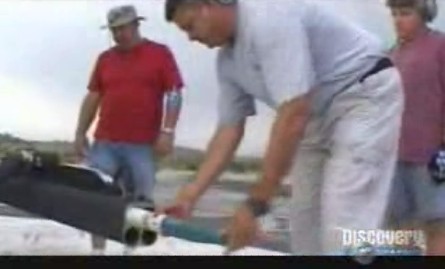
4-shot Hydra 70mm Rocket Launchers Already Exist and are used on unmanned FireScout helicopters
We should have both a Gavin mounted and dismounted capability with 84mm M3 Carl Gustavs recoilless rifles (RRs) organic to every Light IBCT rifle platoon--not just the 75th Ranger Regiment--so we can blast through things like Afghan mud walls. The men are exposed when dismounted and may not be able to get into firing positions though, which is why we need armored tracks to be the primary platform carriers.
 www.youtube.com/watch?v=VvRzOO_avCc
www.youtube.com/watch?v=VvRzOO_avCc
BREAKING NEWS: Return of the 90mm Recoilless Rifle to Combat by U.S. Army Light Infantry in Afghanistan
If the Army bureaucracy won't buy 84mm Carl Gustavs for "lower budgetary life form" light infantry, why not grow a pair of cajones and DEMAND that 90mm Recoilless Rifles sitting unused in storage along with mounds of ammunition be issued to you?
This is exactly what some 101st Paratroopers did to counteract enemy RPG high explosive (HE) firepower and use of cover.
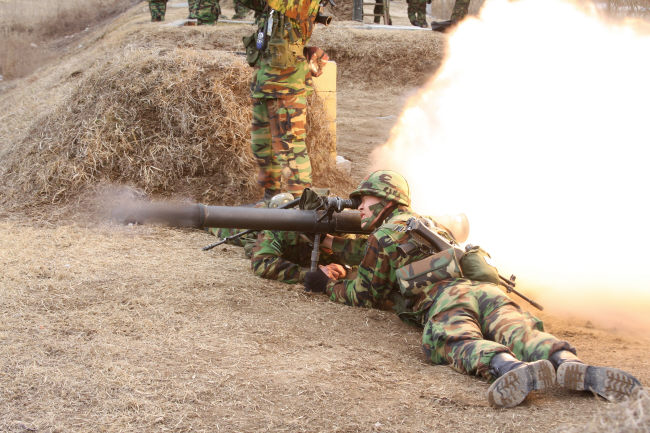
South Korean Army Soldiers Firing a M67 90mm Recoilless Rifle--from the PRONE--so don't say we can't do it
Moreover, it's proof in 1997 the 3rd/73rd Armor Battalion could have attached 90mm RRs to M113 Gavins when they had their M551 Sheridan light tanks taken away from them, and stayed in existence.
www.clarksvilleonline.com/2011/02/12/currahees-add-to-their-weapons-arsenal/


Currahees add to their Weapons ArsenalFebruary 12, 2011
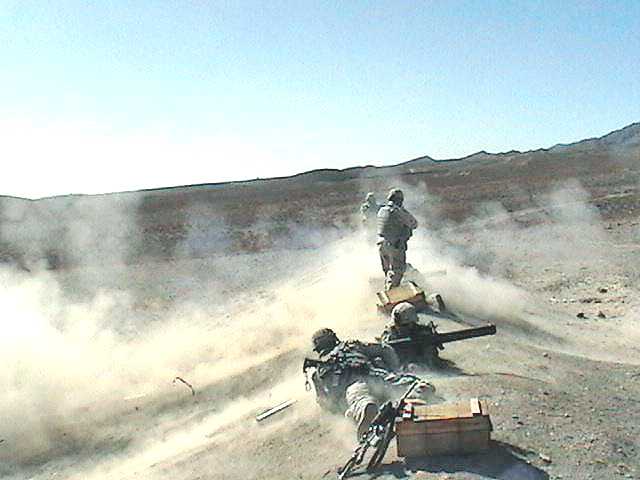
U.S. Army Soldiers from 1st Battalion and 2nd Battalion, 506th Infantry Regiment, 4th Brigade Combat Team, 101st Airborne, familiarize themselves with the M67 90mm recoilless rifle by firing the weapon at a Forward Operating Base Orgun-E range Jan. 27th. The Soldiers fired roughly 150 rounds of 90mm ammunition. (Photo by U.S. Army Staff Sgt. Nathan J. Hyman, 4th Brigade Combat Team, 101st Airborne)
Written by By U.S. Army Spc. Kimberly K. Menzies
Task Force Currahee Public AffairsPaktika Province, Afghanistan - Currahee Soldiers from 4th Brigade Combat Team, 101st Airborne, began incorporating the M67 90mm recoilless rifle into their squads February 10th.
"We chose to utilize the 90mm because we wanted a high-volume fire power weapon that would provide low collateral damage," said U.S. Army Lt. Col. Robert B. Fouche of Columbus, GA, executive officer for 4th BCT, 101st Abn. Div.
The M67 is a lightweight, portable, crew-served weapon designed primarily to be fired from the ground using the bipod or monopod, but it may be fired from the shoulder. It is an air-cooled, breech-loaded, single-shot rifle that fires fixed ammunition and it is equipped with a manually-operated breech and a percussion-type firing mechanism. As a reloadable weapon, it can be used with optics and lasers to fire at night.
The weapon is intended to be used primarily as a self-defense weapon, said Fouche.
"The M67 will be used by mainly infantrymen in a static position," said U.S. Army Staff Sgt. Nathan J. Hyman of Clovis, CA, master gunner for 2nd Battalion, 506th Infantry Regiment, 4th BCT, 101st Abn. "This means the weapon will be stationary, it won't move unless necessary."
"Soldiers at the outlying stations will be able to use this weapons system as a force multiplier, meaning that more can be accomplished with fewer individuals," Hyman said. "Although we plan to use the 90mm in mainly a defensive posture, it also can be extremely effective being used offensively for ambushes."
Not only did the M67 meet the unit's tactical needs, but because it is not a newly developed weapon, Fouche said its use is also a cost-effective alternative.
"This weapon is a beneficial choice for three important reasons," Hyman said. "The weapon has the capability to eliminate an area target using a 90mm flechette round. It is easy to use, meaning it does not require extensive training in order to operate. It is also a reliable weapon and it is easy to maintain in the harsh environments of Afghanistan."
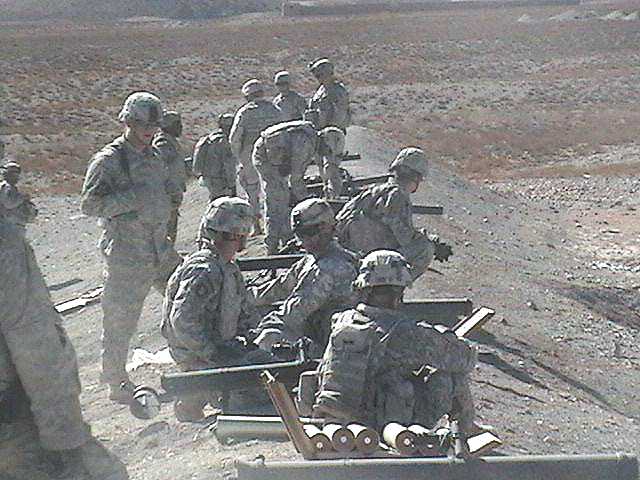
U.S. Army Soldiers from 1st Battalion and 2nd Battalion, 506th Infantry Regiment, 4th Brigade Combat Team, 101st Airborne, wait for the signal to safely begin firing the M67 90mm recoilless rifle during a practice firing of the weapon at a Forward Operating Base Orgun-E range Jan. 27th. The Soldiers fired roughly 150 rounds of 90mm ammunition. (U.S. Army photo by Staff Sgt. Nathan J. Hyman, 4th Brigade Combat Team, 101st Airborne)
The Soldiers only recently received the weapons and have just finished the first training session, Hyman said. The training was held at Forward Operating Base Orgun-E and was primarily attended by noncommissioned officers who can then return to their companies and train their Soldiers.
The training consisted of classroom, hands-on and range training. The classroom portion covered weapon safety, function, use and maintenance.
During the hands-on portion, Soldiers familiarized themselves with various firing positions for the M67, such as prone, seated, kneeling or standing.
"Because the rifle is truly recoilless, it can be fired from almost any position," said Hyman.
At the range, Currahees familiarized themselves with the weapon by practice firing roughly 150 rounds of 90mm ammunition.
The level of noise produced by the weapon firing will also play a factor in the counterinsurgency fight.
The M67 90mm was utilized during the Vietnam War and it continues to be a viable weapon for Currahees in Operation ENDURING FREEDOM.
www.militaryphotos.net/forums/showthread.php?194551-101st-Airborne-Division-adds-M67-90mm-recoilless-rifle-to-their-Weapons-Arsenal/page2
Stating the obvious:
"Omg. Mike sparks was right!"
The hoopla over the missiles or rockets-in-a-box component of the FCS system seeks to give us this, but we don't see any wheels or tracks on these boxes to make them mobile after dumped off by a motor vehicle. And like everything associated with FCS, it looks mega-expensive $$$. In fact, if you read the book, The Bear Trap, this is how the Muj bombarded Soviet FOBs using 107mm rocket launchers brought in by mule-pack. It was the combination of the Stinger SAMs denying air supremacy and the rocket launcher bombardment of the Soviet bases that forced them out of Afghanistan. "Dien Bien Phu" in essence on a smaller scale over a wider area. This should lead us to BATTLEBOX our entire U.S. military so we can have dispersed, camouflaged and fortified FOBs resilient against such attacks. Our air forces must disperse and become ground-mobile with their aircraft, too. Our Airborne must jump higher with drogue-activated parachutes and our resupply logistics must be able to be delivered by delay-opening and guided parachutes and freedrop.
America has gone broke funding military malpractice in Iraq/Afghanistan where we try to run around KE gunslingers all over the place when what we need is combat engineering walls and security fences to keep malcontents separated and out. Like the Morice Line. Gunmslingers are needed to back-up these lines as Quick-Reaction Forces (QRFs). They will not go unemployed but they must stop insisting they be the only tools we employ or the ones that receive all the adulation and emphasis. A fence shouldn't be seen as a threat to one's love life.
http://en.wikipedia.org/wiki/Morice_Line
The Morice Line is a defensive line constructed in the 1950s. It is 200 miles long and was built to prevent Tunisian guerrillas from entering the French Colony of Algeria.Design
The center of the Morice Line was a long electric fence that ran its entire length. This electric fence carried 5,000 volts and also had barbed wire entanglement to one side. The line was surrounded by a minefield that extended 45 meters to each side of the line. On the Algerian side there was also a patrolled track. However, these systems were not the main strength of the line. This strength that contributed to its success came from its then state of the art electronic systems. These alarms, radars and searchlights helped to coordinate a response from the military forces assigned to the line. These attacked forces combined with the previous electronic systems made the line almost impenetrable.
Importance of the Line
The Morice Line had a significant impact of the reduction of terrorist activities by forces that originated in Tunisia. Though this line was not a "fortification" in the traditional sense of the word this line was nonetheless effective in reducing FLN activity during the Algerian War.
Works cited
The History of Fortification, Chicago: St. Martin's Press 1981
 When HE is called in, if its guided, "we lose our shirt" in costs. Our pre-occupation with precision guidance as a firepower panacea may be a manifestation of our physical laziness to earn a direct line-of-sight, kill shot through mechanized maneuver and basic ignorance that kill/capture gunslinging isn't the only forms of military force--nor the only or best ways to smother conflicts. America may even be on the verge of economic collapse because our racketeering military knows no frugality by wise choice. Frugality always has to be imposed upon the American military mind by outsiders who can simply be insiders in uniform who are shunned internally AKA; reformers. We need a field artillery that we can afford that delivers battle and war-winning HE effects; it may not be "Rambo" heroic as the Tom Hanks movie showed no scenes of Wilson gunning down any Soviet choppers, and even Emily Blunt thrown in couldn't make the movie a success, but what matters in reality is that we win--not necessarily at the box office and with weak egos.
When HE is called in, if its guided, "we lose our shirt" in costs. Our pre-occupation with precision guidance as a firepower panacea may be a manifestation of our physical laziness to earn a direct line-of-sight, kill shot through mechanized maneuver and basic ignorance that kill/capture gunslinging isn't the only forms of military force--nor the only or best ways to smother conflicts. America may even be on the verge of economic collapse because our racketeering military knows no frugality by wise choice. Frugality always has to be imposed upon the American military mind by outsiders who can simply be insiders in uniform who are shunned internally AKA; reformers. We need a field artillery that we can afford that delivers battle and war-winning HE effects; it may not be "Rambo" heroic as the Tom Hanks movie showed no scenes of Wilson gunning down any Soviet choppers, and even Emily Blunt thrown in couldn't make the movie a success, but what matters in reality is that we win--not necessarily at the box office and with weak egos.
Self-Propelled Howitzer (SPH) Artillery: Who is going to do Infantry Fire Support?
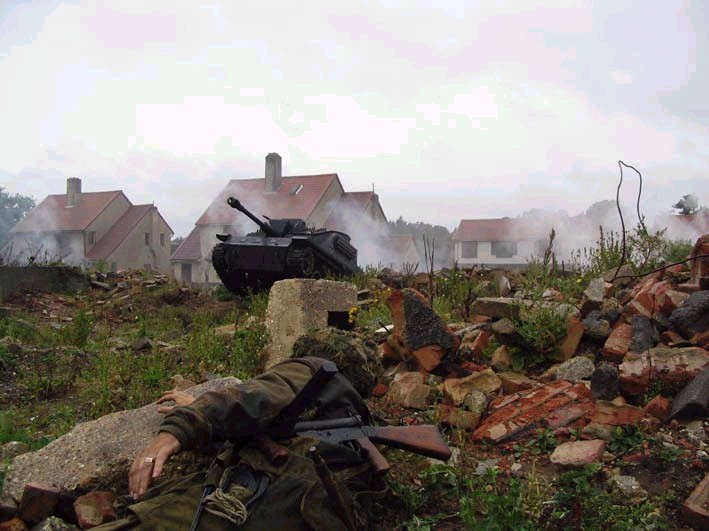
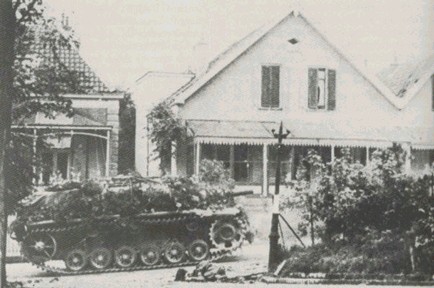
Ranger Larry isn't the first to realize artillery must be self-propelled and in a ready-to-fire configuration. The Germans in the late 1930s realized that a branch of FIELD ARTILLERY had to be created with turretless assault gun tanks in order to keep it wed to the infantry to help it with fire support because turreted panzers tend to be used to get their own maneuver effects. The STUGs were tremendous successes that other armies have not emulated under the false hope that in a pinch their panzers AKA Tankers would do fire support for infantry on an ad hoc basis. We know it doesn't happen or it happens poorly.
http://ibiblio.org/hyperwar/USA/USA-P-Return/USA-P-Return-14.html
U.S. Army in World War 2: The War in the Pacific: Leyte: the Return to the Philippines, Chapter XIV, Measure of the Fighting notes:
"The tanks and tank destroyers could have been used more frequently and with greater versatility.
Situations often arose in which an infantry platoon was held up by enemy machine gun and mortar fire, but "the use of indirect artillery fire was impracticable either because of overhead cover for the enemy weapons or because of undue risk to our enveloping infantry." General Krueger recommended that the infantry employ direct fire by the tanks or tank destroyers. He felt that "the tank destroyer commanders lacked aggressiveness and skilled direction." [14] The tank destroyer commanders admitted that they were idle but added that the infantry had not called for them. The tanks and tank destroyers were ideal weapons for the destruction of machine guns, mortars, and other heavy infantry weapons, but the infantry commanders seemed to be unaware of their capabilities. Many commanders employed their armored vehicles down the middle of the road when they could have used them more effectively on the flanks and for envelopments."
Thus, leaders like British General Percy Hobart had to create specialized "Sapper Tanks" and special units to get the job done on D-Day and afterwards to win WW2.
 WATCH THE CLASSIC MOVIE, "The Longest Day" based on Cornelius Ryan's Book
WATCH THE CLASSIC MOVIE, "The Longest Day" based on Cornelius Ryan's Book

Click on the picture to view the 2-hour movie; which shows the pitfalls of foot-infantry not having tracked tank fire support on Omaha Beach and the triumph of the British and commonwealth forces that did have it and used bicycles to move rapidly inland after the enemy's fortifications were breached...
Movie details: www.imdb.com/rg/video/browser/title/tt0056197
The inherent weakness of towing field guns is they are NOT READY-TO-FIRE and their crews are EXPOSED to enemy fires.
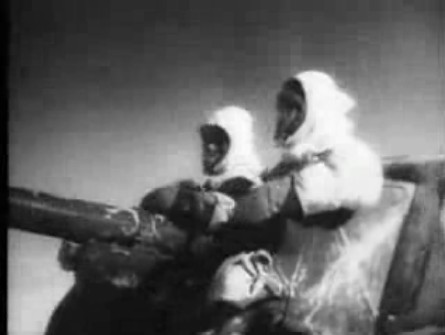
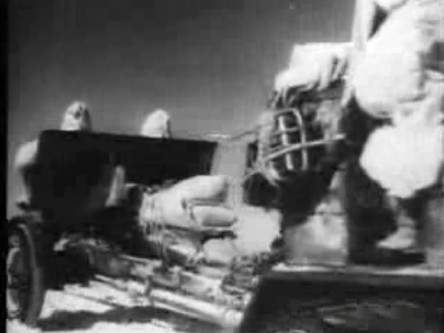
Russian Soldiers riding on their field guns in 1945 Manchuria
Even if your gun is towed by an ARMORED track, there's no guarantee that enemy fire will let you get out to put it into action
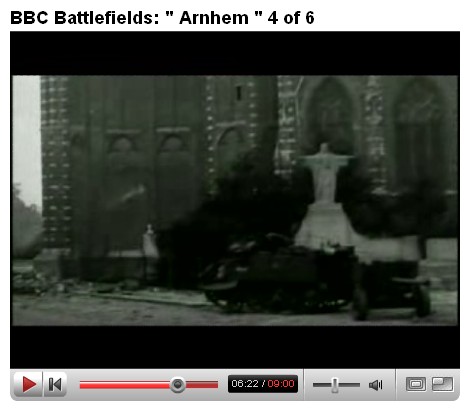
Bren gun carrier towing 57mm AT gun during Arnhem battle
A mere pair of armored cars and some training students with rifles stopped two elite parachute battalions from reaching Arnhem bridge to reinforce LTC Frost who took an unopposed route. LTG Gavin reports that their jeeps towing 20mm AA or 57mm (6-pounder) AT guns couldn't get into a return fire condition against the ready-to-fire armored cars.

We know that Freddie Gough's Recce Squadron towed Polsten AA cannon. Whatever gun types they were towing, this inability to immediately return high explosive cannon fire to ward off a mere pair of armored cars RESULTED IN THE DEFEAT OF AN ENTIRE BATTLE EFFORT WITH STRATEGIC NEGATIVE CONSEQUENCES.
Most everyone thinks the Germans are the epitome of military efficiency so let's see how long it takes them to stop, unlimber and put into action a small 37mm towed, anti-tank gun which was their bread 'n butter AT means early in the war.
Watch video at full speed fast forward to 9:30:
 www.youtube.com/watch?v=tpJhxW9tnWU
www.youtube.com/watch?v=tpJhxW9tnWU
The small unarmored, wheeled truck stops at 9:32.
Still Sequence
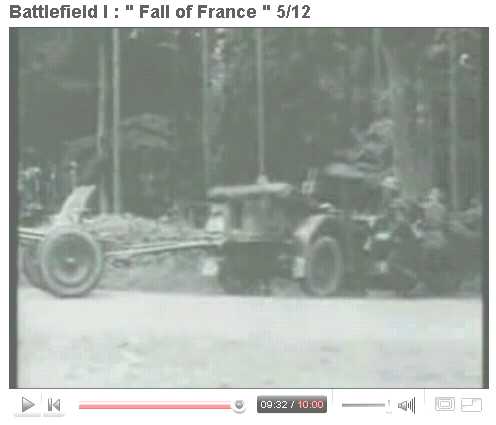
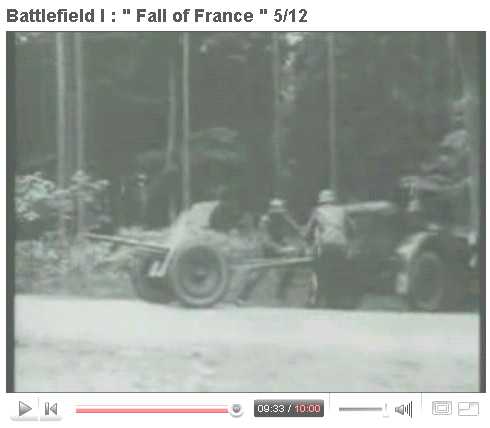
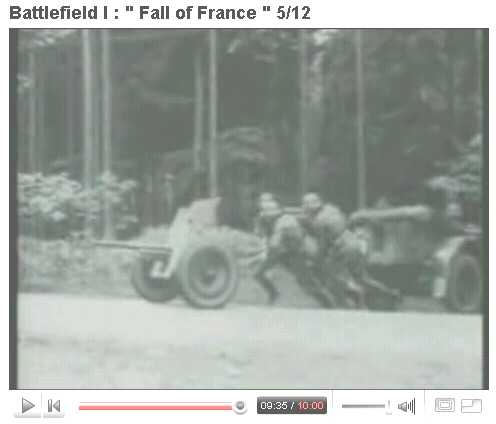
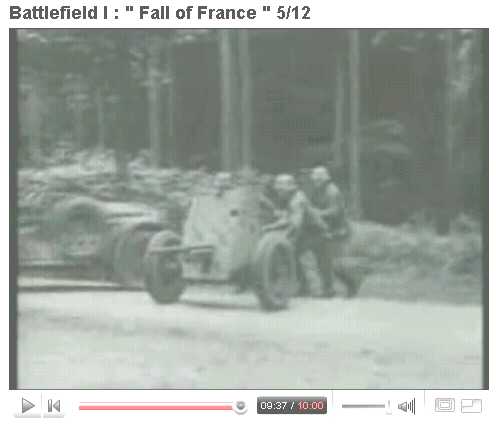
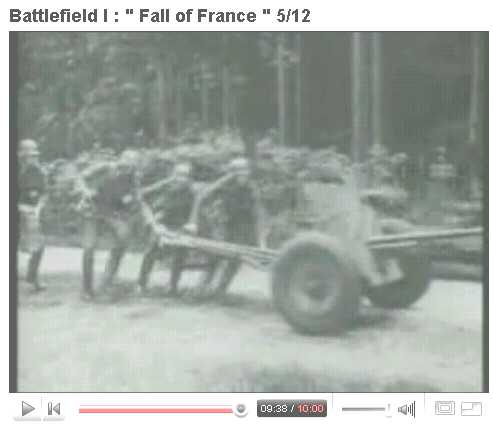
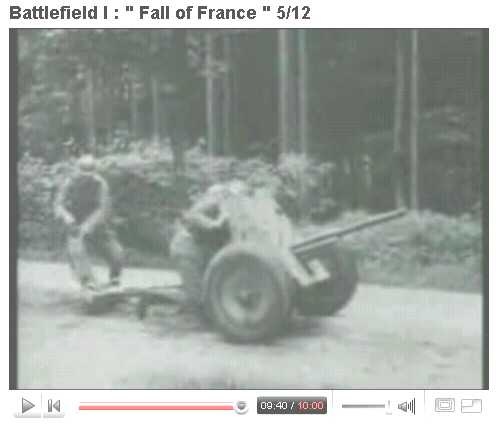
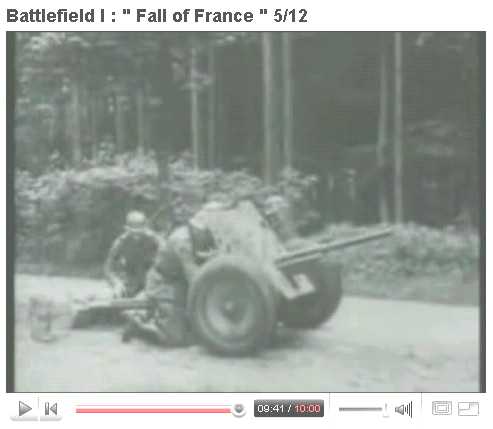
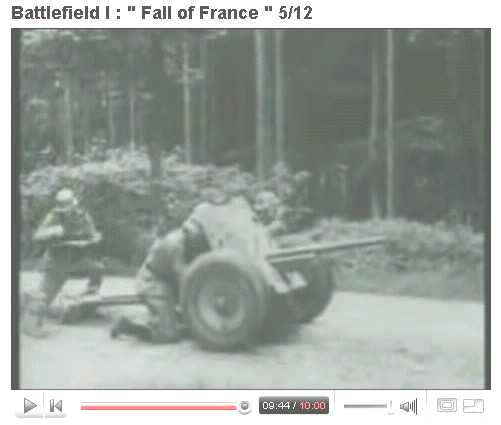
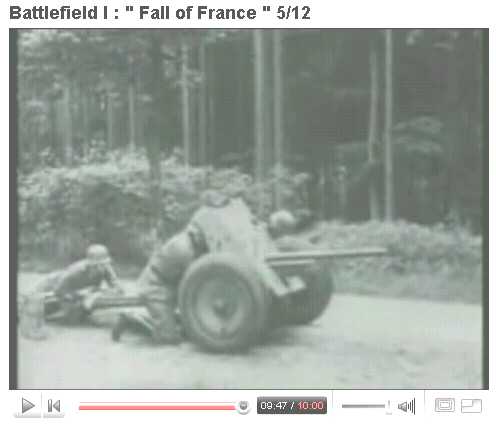
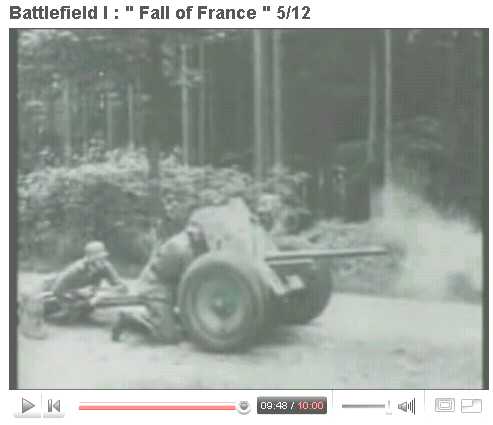
The AT only fires what looks to be one round already in its breech at 9:48, so it takes 16 seconds under ideal conditions to get a towed AA/AT gun on a paved road into action. A less efficient crew would take longer. In a meeting engagement when the enemy spots you or you spot them and both sides open fire, the towed AA/AT gun crew cannot return fire for a fatal 16 seconds. A lot can go wrong.
1.) Crew is killed and truck/towed gun destroyed before they can dismount
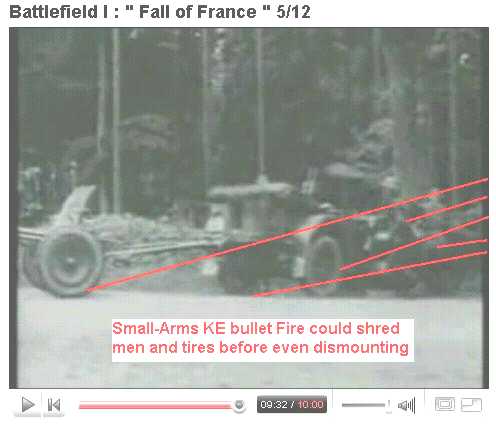
2.) Crew is killed after they dismount, truck and gun still vulnerable to destruction
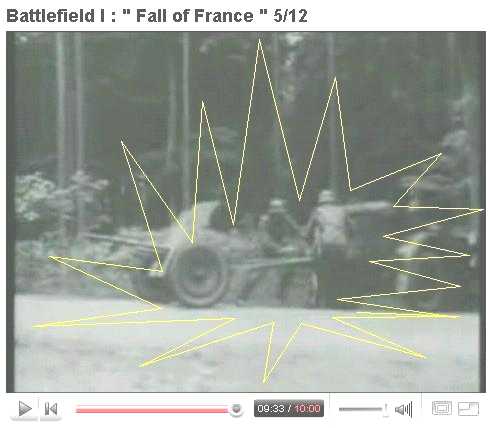
3.) Crew is only safe from frontal small arms fire 15 seconds later by virtue of a gunshield (U.S. towed guns no longer have these today) , but bullets can shred the gun's tires and immobilize it
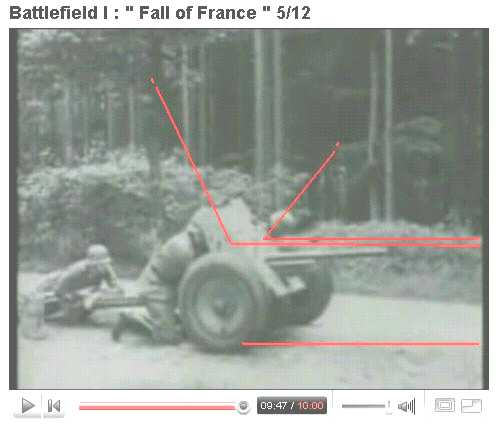
4.) Any high explosive near miss BEHIND the gunshield wounds and kills the crew
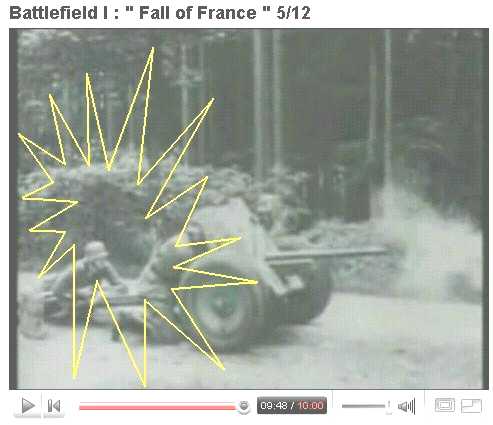
The Airborne needed then and still needs today a "MINI-STUG" if not a turreted light tank then at least a tracked armored vehicle with a large caliber gun in a fixed mounting that can turn and immediately blast through enemies. LTG Gavin's advocacy while in PROJECT VISTA of the Ontos with 6 x 106mm forward-firing on the hull verifies he understood the need for vehicles immediately ready to return fire in event of meeting engagement. The British had attached towed guns to their Bren gun carriers so why a 75mm pack howitzer couldn't be mounted in a ready-to-fire manner is a good question that demands answers. Our light mechanized cavalry modified Stuart light tank turrets to carry the 75mm pack howitzer in the M8 SPH variant in WW2.
http://afvdb.50megs.com/usa/75mmhmcm8.html
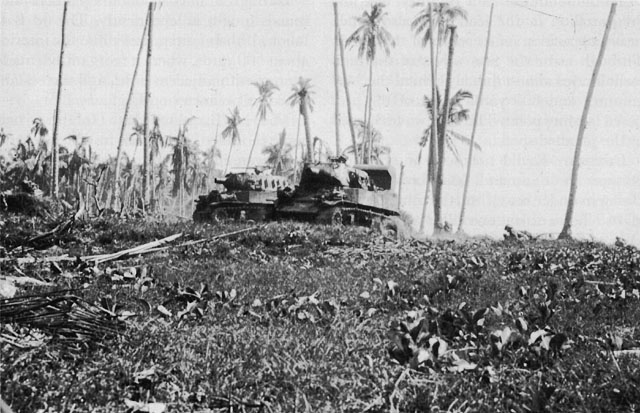



http://ibiblio.org/hyperwar/USA/USA-P-Return/USA-P-Return-14.html
U.S. Army in World War 2: The War in the Pacific: Leyte: the Return to the Philippines, Chapter XIV, Measure of the Fighting notes:
"The 7th Division found the [M8] 75-mm. self-propelled howitzer [mounted on a Stuart light tank chassis], because of its superior mobility, to be the most effective infantry weapon for reduction of Japanese pillboxes."
The failure of the British to concentrate in force on Arnhem bridge damns the entire operation! Had the 1st and 3rd battalions reinforced Frost at the bridge they would have held out long enough for even the tardy XXX Corps to arrive and link-up.
The Battle for Arnhem was lost because jeeps towing anti-tank (AT) guns could not get into action to knock out or drive away a mere two German armored cars blocking the British Paratroopers from consolidating and holding the bridge over the Rhine river. For some inexplicable reason Hobart's "Funnies" that included tanks with assault guns under armor in a ready-to-fire manner were not employed by Field Marshall Montgomery for the Operation Market-Garden battle even though we know they were available.
 www.youtube.com/watch?v=VSm5nBZ4X0A
www.youtube.com/watch?v=VSm5nBZ4X0A
Post-WW2 What Right Looks Like, Remembered
Along the way that good and bad "cake" vehicles were being developed and fielded, some important firepower "icings" were fitted. The need for lightweight firepower adequate to kill tanks and blast buildings was articulated by General Gavin in his visionary book, Airborne Warfare in 1947. In it, he called for light tracked AFVs with recoilless weapons to get the necessary "bang" without the heavy recoil dampening mechanisms of regular cannons that at that point made it difficult to get into an under 10-ton package to be air-transportable by parachute drop from fixed-wing aircraft, let alone by helicopters with even less payload capabilities. The fantastic M40 106mm recoilless rifle came into service derived from the successful 75mm RR used in combat in WW2 and Korea. The Army and the marines quickly seized upon the 106mm RR and came up with a low-tech answer to the exposed loading/backblast problem: mount 6 of them to the sides of the tiny T55 carrier and have them already loaded and steer the entire vehicle to get a general aiming and fine tune the aiming from there all like a WW2 German assault gun. Fielded as the M50 Ontos, it was highly successful in combat in Vietnam and was CH-53D helicopter air-transportable but the marines gave up on it in favor of completely unarmored TOW ATGM jeep 1/4 trucks. They didn't just "throw the bath water out", they also discarded the 106mm RR even on jeeps and M274 MULE platform trucks even though this powerful weapon had saved the day for them on numerous occasions in desperate battles in Hue City and the siege of Khe Sanh. This legacy of not having firepower manifested itself in the aftermath of Vietnam with the USMC not mounting 105mm howitzers on their new LVTP-7s (now called AAV-7s) like the older amtracks had and were successful in Vietnam with. The garrison mentality quickly smothered war-winning common sense measures that require money, effort and time that cuts into parade ground BS.
The Army of the 1950s also needed lightweight anti-tank and bunker-busting firepower and placed 106mm RRs onto jeeps using exposed mounts, and this technique was also used to mount onto M113 Gavins to devastating effect in Vietnam. Why 106mm RRs couldn't have been fielded on the XM733 class of tracked AFVs to be helicopter air transportable fire support for the Air-Mobile troops in Vietnam also becomes a question. Now the criticism of the 106mm RR is always that "the gunner is exposed" loading and firing it. As if the TOW gunner on top of a Humvee truck is not who has to sit there and track the missile all the way to its target for a potential 20 seconds to a maximum range of 3, 750 meters? But did you know that the U.S. Army in 1954---that's right 1954--had a 3-round autoloader 106mm RR 1-man turret perfected that SOLVES THE GUNNER EXPOSED PROBLEM and then REJECTED IT?
U.S. Army Perfects 106mm RR Lightweight Turret
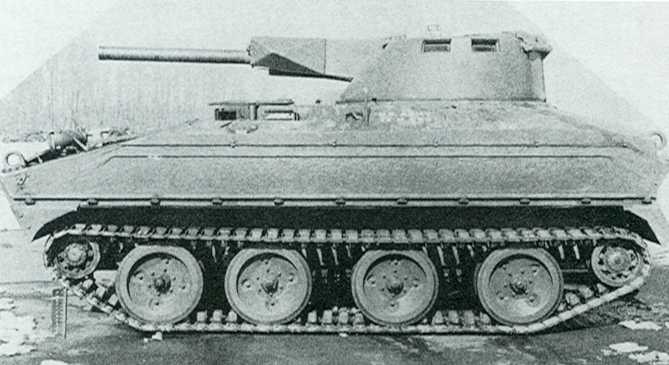

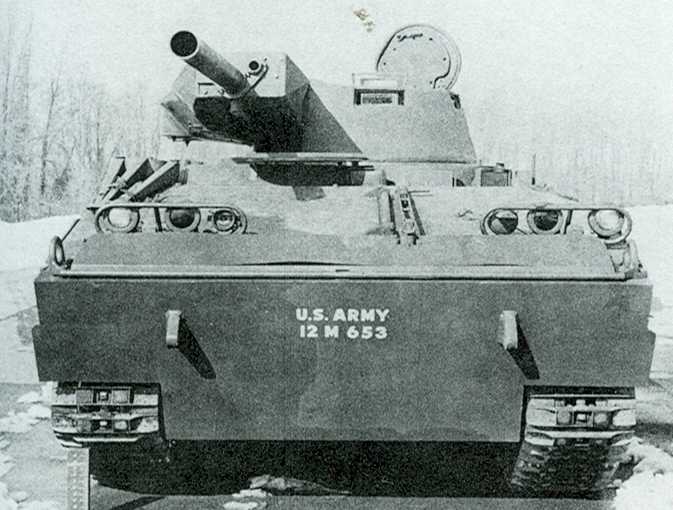
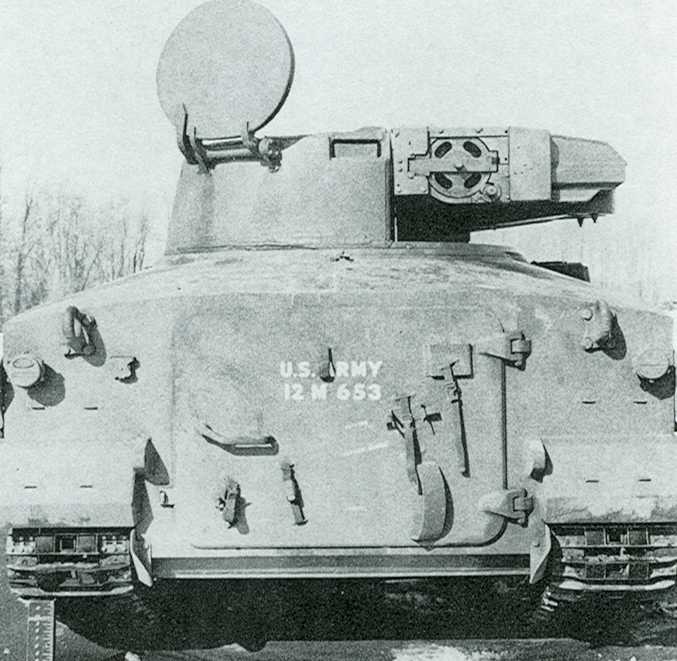
The AutoLoader
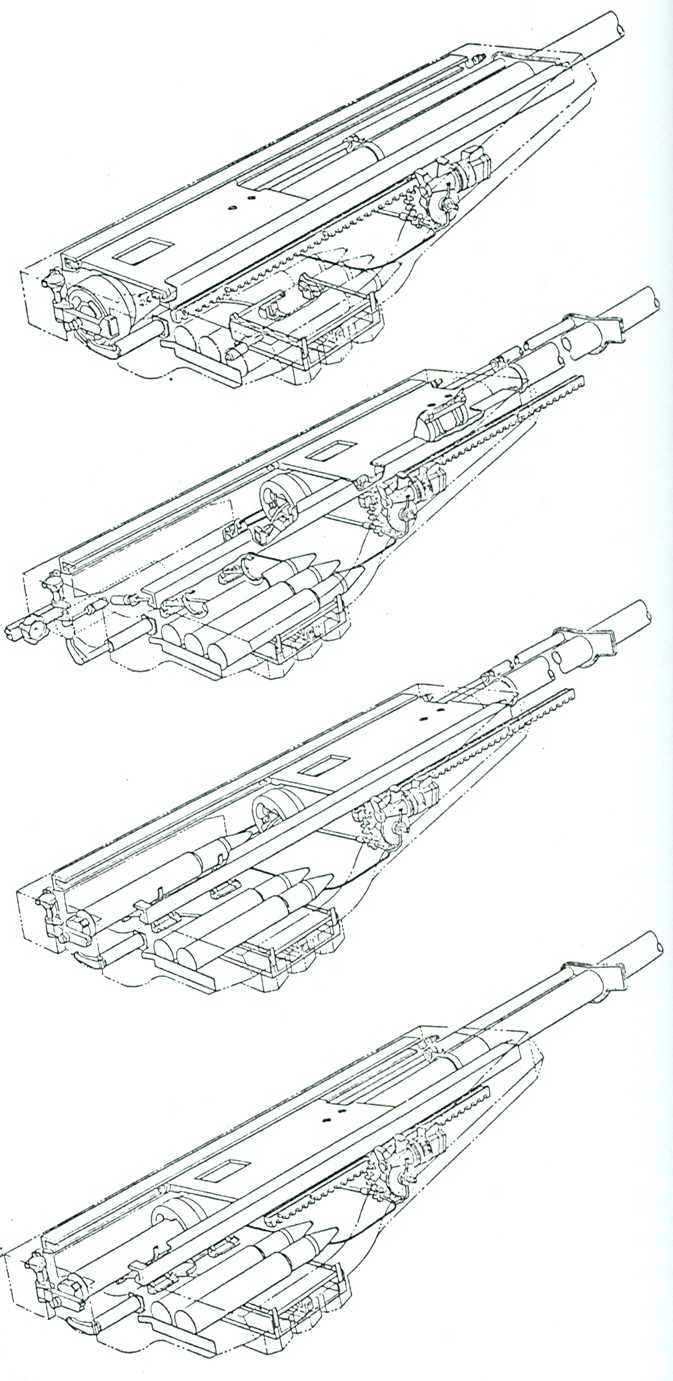
HEAT Round (fin stabilized)
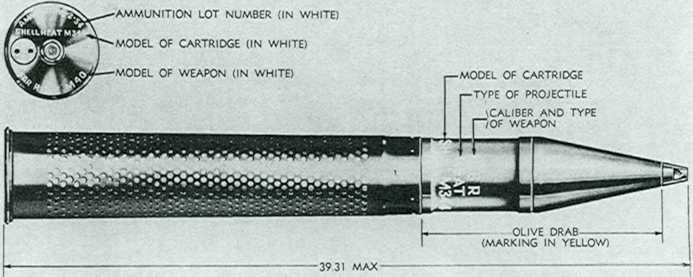
HEP round (spin-stabilized)
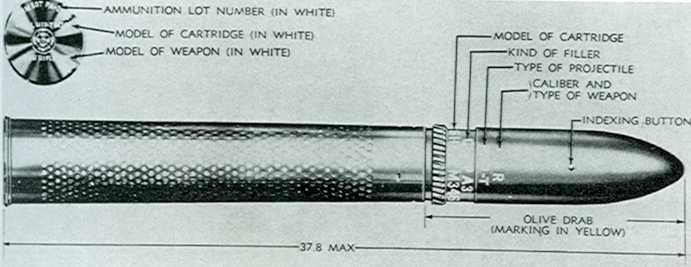
Yes, the M114 tracked chassis would later on be discovered as bad "cake" to carry anything or anyone. But this doesn't mean the good 106mm turret "icing" couldn't have been brilliantly applied to an excellent M113 Gavin "cake" to create a fearsome tank and bunker killer that is highly cross-country mobile and amphibious. The hull of the Gavin could easily carry 100+ rounds of 106mm to feed the 1-man turret and stay well within C-130 payload limits. We now have the helicopters to lift this combination, too. Starting in 1960 we could have and should have had a M113 Gavin based 106mm RR assault gun that would have saved countless lives and won many battles in Vietnam, Grenada, Panama, Afghanistan and Iraq. We need such a system TODAY.
ARMY FIELDS A 20MM EXTERNAL AUTOCANNON IN COMBAT, THEN FOGETS ABOUT IT!
The inability of the Army to differentiate the good from the bad never ceases to amaze the authors. Discernment seems impossible in corrupt, bureaucracies that racketeer. After the M114 was cancelled, the good M27 20mm autocannon was made better by being able to be fired with the hatch closed and placed on a M113 Gavin in 1975 to make for an excellent scout vehicle called the armored cavalry cannon vehicle (ACCV). Instead of applying this to hundreds of M113 Gavins to get an immediate saturation fire capability to defeat a BMP, the Army opted instead to squeeze the autocannon need to get an entirely new, from scratch XM800 scout vehicle from Congress when the "M113 1/2" Lynx was already available and SUPERIOR in mobility performance!.
 www.youtube.com/watch?v=ddnntGA8vEs
www.youtube.com/watch?v=ddnntGA8vEs
This constant peddling (racketeering) of ill-conceived schemes to get budget, power and prestige from Congress has no doubt over the years damaged the trust and put the Army in a bad light by Washington policy makers. When Congress rejected the XM800 it led the proud Army to slap on the scout requirement onto the Bradley infantry fighting vehicle when we should have been professional and humble and went back to the proven M113 Gavin and derived an enhanced scout vehicle.
 www.youtube.com/watch?v=f9TD4mQtavg
www.youtube.com/watch?v=f9TD4mQtavg
 www.youtube.com/watch?v=SL6ZkyAU5cI
www.youtube.com/watch?v=SL6ZkyAU5cI
 www.youtube.com/watch?v=OeRJVhMV_IM
www.youtube.com/watch?v=OeRJVhMV_IM
Watch the HBO black comedy "Pentagon Wars".
 www.youtube.com/view_play_list?p=22E0BF09EE911082
www.youtube.com/view_play_list?p=22E0BF09EE911082
Because of this mistake, the Army's scouts are either in unarmored or poorly armored rubber-tired Humvee trucks that cannot survive contact with the enemy nor swim or armored and heavily armed M3 Cavalry Fighting Vehicles that are too heavy to fly by helicopters or C-130s and cannot swim. We have the worst of both light and heavy worlds. In the Army's perpetual quest for "perfect" systems that prove failures and at best so costly only a few can be obtained, the entire force never gets transformed and stays at the rifle-in-hand, ruck-on-back hitch-a-ride-in-a truck default that the brass is so comfortable with in garrison.
Had we equipped all our M113 Gavins with high-velocity autocannons in the early 1980s we could have had not only organic self-defense from air attack up to 5,000 feet but building busting fire support capability in the light infantry units of our Army since the Gavin weighs exactly the same as the FMTV trucks they use. Simple 2.75 inch Hydra-70mm rocket launchers are put on smoke screen-laying M113 Gavins to project a smokescreen into the enemy's face to defeat RPGs and ATGMs, but rejected. Brass realizes someone smart would then figure high explosive 2.75 inch rockets could be fired, giving the underclass Chemical unit Soldiers a COMBAT capability reserved only for the narcissistic infantry/armor Soldiers. We can't have them help out and take our glory!
NO ROCKETS FOR YOU!
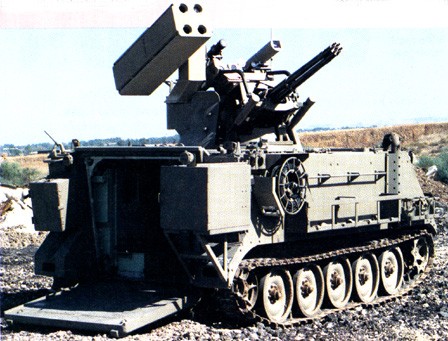
Army Air Defense Artillery (ADA) units in the 1990s retired both their towed and M163 armored tracked 20mm Gatling cannon Vulcan weapons systems in favor of measly vulnerable, Humvee trucks with Stinger SAMs and an impotent .50 caliber heavy machine gun with a small amount of ammunition for light units. Hunnicutt shows a Stinger missile pod attached to the 20mm Gatling Vulcan was offered but rejected, raising the question if Army Air Defenders want to do anything but keep their heads in the clouds looking for non-existent Soviet MIGs when if they had autocannon along with SAMs (like the Russian Tunguska) they could pitch in and help win the ground fight like Vulcans did in Vietnam...and quad .50 calibers did in WW2 and Korea....Meanwhile, the IDF has FIELDED the Vulcan/Stinger M113 Gavin variant (see above)! When marine and army officers Carlton Meyer and Mike Sparks propose that 2.75 inch rocket pods can be attached in place of Stinger pods to give Avenger Humvees a ground attack capability, both Army and marine air defenders are not interested. It makes one think that deep down inside ADA doesn't want to fight, doesn't it?
Today, a unit is lucky if it has a .50 caliber heavy machine gun on its trucks, the norm is a medium 7.62mm or a light 5.56mm machine gun with NO MOUNT; just a lower-ranking Soldier standing exposed in the back of the unarmored truck. Do not mistake the desperation slapping of one layer of armor onto the trucks in Iraq as "transformation". The rest of the Army is unchanged and when they rotate to do a tour in Iraq will use these same trucks until they are worn out and discarded which is what the brass wants--to return to the pre-war state where vehicles are unarmored and unarmed. Its clear that the Humvee and now Stryker wheeled truck mentalities are the manifestations of a deeper desire to demilitarize within the U.S. military while the light narcissists beat their chest how they are validating their manhood.
SO WHAT IS WRONG WITH THE ARMY & MARINES, DON'T THEY WANT TO WIN IN COMBAT?
The inescapable answer is NO, they do not.
As Norman Dixon documents brilliantly in his book, On the Psychology of Military Incompetence, the militaries of the west are populated by weak people with hang-ups about not only their masculinity but want a safe, garrison lifestyle where everything is set for them so they needn't have to think while projecting a strong image of masculinity to the outside world. The anal retentive military mind is obsessed with control; weapons and ammunition are locked up and as Dixon says the "sword is always blunted" because deep down inside, these weak people are afraid of the pandora's box of life let alone COMBAT. Driven by a basic lack of self-esteem based on the intrinsic value of ALL human beings, the western military mind cannot trust subordinates---who are looked down on as an inferior social class---and supply them FIREPOWER via a lightweight, portable weapon on a tracked armored vehicle that is self-sufficient. Firepower is only reserved for the "gods" the higher ranking brass through artillery and directed aircraft bombings not the lowest level where it is most needed immediately to save our men's lives. Remember, we learned war from the methodical and snobby French chateau generals in WW1. What General Gavin wanted from WW2 non-linear warfare experience with Paratroopers dropped deep into enemy territory where the threat was all around them is diametrically opposed to the linear, snobby, condescending outlook of the weak co-dependants who want to move cautiously ahead with the enemy only to their front so they can pour artillery and aircraft firepower on them from a safe distance. So as you study American military history from a Dixonian perspective, the absurd decisions that are constantly made with no combat logic become clear as manifestations of the mental illness that inhabits the narcissistic military mind. Its always easier to DO LESS---not more in today's blind obedience, lemming military where higher ranks get to order those around with unquestioned authority. Notice when the M728 CEV was retired a smart combat engineer suggested we put 165mm demolition guns in M1 tanks---we have hundreds sitting unused---and the capability was NOT retained. The military's downsizing mentality is a loser's mentality--do LESS WITH LESS. At the highest ranks, this means no Congressional oversight of how the Pentagon spends money unless a Congressman/Senator has either the common sense logic or past military experience to see through the BS and demand military excellence based on combat demands.
WHY WIRE-GUIDED AND EVEN FIRE & FORGET MISSILES WILL NOT WIN THE CLOSE FIGHT FOR US
Wire guided missiles will fail miserably in closed terrain like Korea against a swarming enemy. A good crew can fire two rounds of high velocity ammo from a gun, before one round from a wire guided missile can reach it's target. LOSAT and high velocity laser beam riding missiles (Hellfire) are the only smart way to use missiles, but they are not available on ground mounts/vehicles yet in the U.S. Army. Fire & Forget missiles are simply too costly to field in the numbers needed to blast all the tanks and buildings and bunkers we need to bust. There is still a big place for guns on the modern battlefield, especially combined with the latest range finders and the latest optical advances like FLIR to get 100% one-hot/one kill capability, day or night. With the proper use of technology they can have the same first round hit probability as the wire guided missile.
We have heard some suggestions lately that tanks are done. We do not concur.
Highly mobile gun platforms will always have tremendous advantages. We may have to change the shape and improve ballistic protection but they are too important not to have. Right now if we had a decent light tank with a good gun and the right ammo (HEAT, AP, HE-FRAG, HEP, and Canister) we could optimize the tanks abilities and move them quickly all over the world. This could be done at considerably less cost and greater speed than the M1 and other heavy land-mastadon "MBTs".
The following quote from the Korean war Web site has me grinding my teeth.
"Russian weaponry, as Russian equipment generally, had one marked characteristic: it was extremely rugged, of the simplest design consistent with efficiency, and very easy to maintain, making it suitable for the equipping of peasant armies. Despite its simplicity and lack of refinement, it was good."
What's wrong with non-peasant armies having good simple and reliable equipment?
The old Soviet union produced a variety of weaponry, meant to fight on all battlefields for about a tenth of what we spent. Towards the end of the Soviet Union they started trying to copy us. Recently in Grozny they had to ship AT Guns and Heavy Mortars from reserve units to the city. The western-style equipment for open area Desert Storms were all but useless in the closed terrain fight. They were reduced to fighting the Chechens with AKs and other personnel weapons, which of course the Chechans had, too and in greater numbers. The simple RPG-7 was the deciding factor in most fighting. The Soviets didn't have enough of them and believed that mechanized units with BMPs and MBTs would do the job. Wire guided missiles turned out to be useless and the lack of HE in tanks made them ineffective after firing most of their HE (five rounds). The Soviets were the last country on earth to produce assault guns and towed anti-tank guns. They had mothballed them in the late eighties and were forced to bring them back for Grozny. We can't even bring them out of storage. The Russians were lucky.
ARE WE GOING TO BE OUT-GUNNED ON THE NEXT NON-LINEAR NATION-STATE WAR?
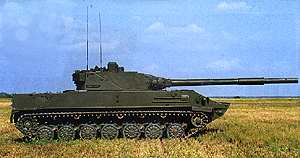
WHAT WE CAN DO TODAY TO GET BIG GUNS TO THE BATTLE?
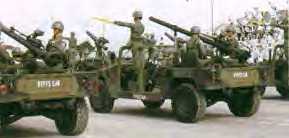
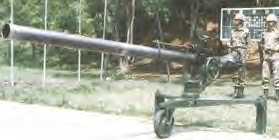
The U.S. being "out-gunned" began in WWII, where then Colonel James M. Gavin's Paratroopers fired 2.36" bazookas at German Tiger I tanks and got killed on Biazza Ridge on Sicily. Fortunately the wily Gavin insisted on taking 75mm pack howitzers instead of light mortars and he held the ridge, saving the invasion of Sicily. Immediately work on a 75mm recoilless rifle that could be air-delivered began and was used by the 17th Airborne Division for the jump across the Rhine in 1945. General Gavin wrote in Airborne Warfare after the war:
"I should point out the rapid strides toward improvement of the weapons now available to Airborne troops for ground combat. Recoilless artillery, hollow charge weapons such as the bazooka and panzerfaust, lighter metal in weapons construction have all improved the chances of survival on the battlefield for Airborne units of all sizes. In fact they can not only survive, they can carry the attack to the enemy deep in his own territory.The 75mm Recoilless Rifle grew to be the awesome 106mm Recoilless Rifle!It is interesting now to recall that as late as 1942 the faculty of one of our leading service chools was generally of the belief that Airborne operations were "impossible" on a divisional scale..
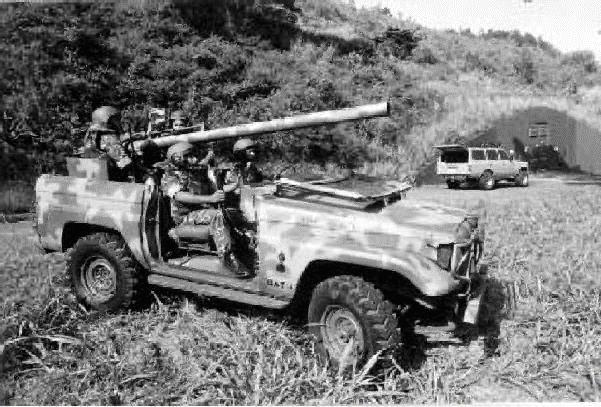
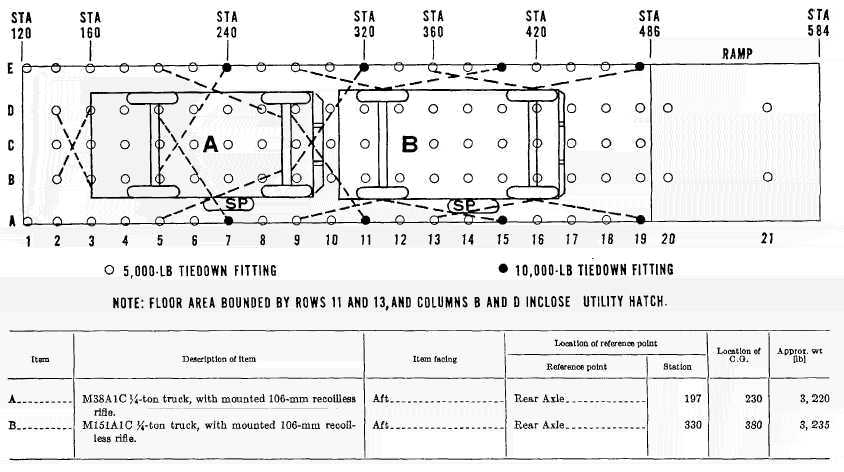
2 x jeeps with 106mm RRs in a CH-47 Chinook Heavy Lift Helicopter
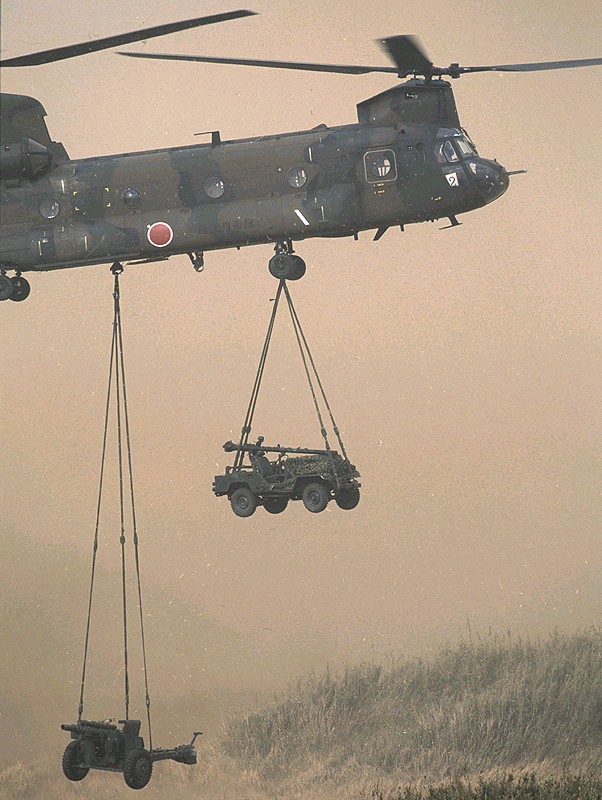
Dominican Republic, 1965
www.bragg.army.mil/history/HistoryPage/powerpack/PowerPack.htm
Vietnam, Hue City, 1968The order not to fire unless fired on or in imminent danger of being overrun was imposed on the U.S. Soldiers due to the politicians' fears that too much aggressiveness on the part of the military would lead to a breakdown in diplomatic initiatives. It was unfortunate for the paratroopers who found themselves bound by these rules that once the rebels learned of the no fire order they increased their confrontations. To avoid becoming sniper fatalities, the troopers moved tactical operations from the street to the rooftop level. Rebel snipers caused most of the American fatalities--13 KIA and 200 WIA for the All Americans. The 7mm bolt-action Mauser rifle used by the rebels had very definite advantages over the newly fielded American [5.56mm] M-16[A1]. It had greater range and its higher caliber passed easily through the lumber and concrete block construction common in Santo Domingo, while the M-16 was prone to jam frequently and lacked telescopic sights. The paratroopers countered this ballistic handicap with characteristic ingenuity. It didn't take them long to figure out that while doctrine might dictate buildings be cleared from the top down, doing so in Santo Domingo would earn you a one-way ticket home in a body bag. If taller buildings overshadowed a key objective, it would be cleared from the bottom up, with adequate covering fire to discourage the ever-vigilant snipers. Adequate covering fire included the 106-mm recoilless rifle, which had the advantage of not only killing the sniper but also destroying the building that had concealed him. Through admirable fire control the All-Americans quickly turned sniping into a suicide mission.
It was this restraint, perhaps, that proved to be the key to obtaining the Constitutionalists and Loyalists signatures on the OAS-sponsored Act of Reconciliation in August. Now, from a peak strength of 24,000 in May of 1965, the U.S. could safely begin redeploying the marines and Paratroopers who helped engineer this rapprochement of brother with brother. The last All American would leave the Dominican Republic in September 1966 after Joaquin Balaguer was sworn in as the freely elected President.
Elements of the 82nd Airborne Division discovered the anti-sniper possibilities of the 106mm Recoilless Rifle in their Santo Domingo operation....if you can do the job with firepower instead of troops, then thats the right way.
..elements of the 1/17th Cavalry had to push to the west bank of the Ozama river across the Duarte Bridge, which was nearly a kilometer long. When the point element was almost to the western end, they began receiving heavy sniper fire from an apartment house, pinning down the element and inflicting casualties.
Other elements supporting by fire from the east bank, but the apartment house was beyond the tracer burnout of their M60s. As a result, jeep-mounted 106mm Recoilless Rifles were brought up. The .50 caliber spotter rounds were adjusted on the sniper's windows. Then, whenever a gunner saw a puff of smoke at the windows he was covering, he fired his main gun. The sniper's effectiveness was quickly diminished, which allowed the unit on the bridge to finish its push to the west bank of the river.

A squad leader who served in World War II and Korea said: "we used to send four marines to get a sniper. But here, the AK47 on automatic can pin down a whole company just like a well-emplaced machine gun"
www.youtube.com/watch?v=9MZvEUlSwqU
www.youtube.com/watch?v=eYu_oo3JpOA
Unlike the jeep-mounted 106, the Ontos provided some limited cover for its gunner. It was more maneuverable in narrow streets than a tank, allowing it to move quickly to a covered position after expending its ordnance. The gunner could ripple fire his weapons with HEAT, HEP-T and flechette rounds.
Crew-served Recoilless Rifles can be employed in pairs or loaded with an anti-personnel round, a single 106 can be combined with several LAWS.
--CPT Grady Smith "Old Doctrine, New Techniques", Infantry magazine, May-June 1971, Page 28
In Hue, we also learned that NVA, positioned along a street several blocks away were able to place accurate grazing fire down the street. Since the street had to be crossed, we used the backblast smoke of the 106 to cover and conceal movement across the street. This was done by popping smoke, a tactic that always drew enemy fire, to reveal the enemy's location.
Then a "mule mounted" 106 was moved partially into the street and a round was fired at the NVA position. (The jeep mounted 106 could be employed in the same way.) This caused the enemy to duck their heads and allowed us to move across the street, concealed by the backblast smoke and dust. Once a foothold was gained in the next block, fire could be directed from a new position to eliminate the NVA resistance.
"CPT Smith's assessment of the value of the 106mm Recoilless Rifle is quite accurate. In Hue, it was a real workhorse. By 'trial and error' we learned several helpful points in mind when deploying the 106mm in a city environment. We found that it was more effective to aim the 106 just below the window where the snipers werre located, rather than fire through the opening. This creates more shrapnel than a round that sails through the room. This is equally true for the LAW and the 3.5 rocket launcher.
CPT G.R. Christmas, Instructor U.S. Army Institute for Military Assistance, Nov-Dec 1971 Infantry magazine page 53

"The 106 is a real combat veteran. It has been extremely effective in Vietnam, primarily as an anti-personnel weapon utrilizing the beehive round. However the 106 doesn't fully meet the HAW requirements and is programmed to be replaced in the near future by the TOW."MAJ Robert Dutcher and CPT John Cooke "HAW, MAW, LAW: the anti-armor family", Jan-Feb Infantry magazine, Page 50
Saigon: M113 Gavin ACAVs with 106mm RRs Save the Day!
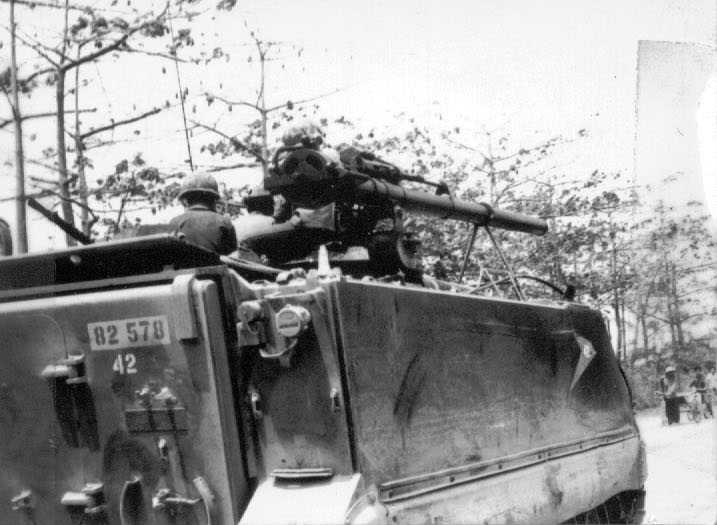
Mavinga, Angola, 1990
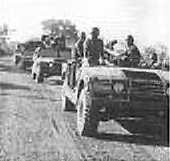
The forces of UNITA used HUMMWV-mounted 106mm Recoilless rifles to decisive effect in the 1990 battle of Mavinga. U.S. Army 5th Special Forces Group "Green Berets" used 106mm RR mounted HMMWVs to storm back into Kuwait with Arab coalition forces they were advising. The 106mm RR is a battle winner from the jungles of Vietnam to the deserts of Israel, the airfield at Entebbe...Both the Israeli Defense Force and Taiwan make their own 106mm RRs and ammo.
However in the late 1970s for the majority of the U.S. military, we replace 106s with TOW HAW ATGMs to destroy Soviet tanks at the Fulda Gap, all the hard-lessons learned in Vietnam, discarded, along with many combat leaders. But the threat of overwhelming Russian tank armies is over, the enemy is an irregular hiding in the city, like the VC/NVA. These same Battle-proven M40A2 106mm Recoilless Rifles are awaiting a use in U.S. Army Anniston arsenal storage and are ORGANIC to U.S. Army Special Forces Operational Detachments. 250,000 rounds of bunker-busting HEP, APERS "beehive" flechettes, and HEAT are in storage. New Bofors 3A-HEAT-T 106mm rounds will defeat the latest tanks with explosive reactive armor tiles on, is effective out to 1800 meters and is 90% first round hit accurate using the Canadian CLASS laser sight. The Canadian Army used to mount 106mm RRs on M113 APCs, jeeps, the Australian Army's on M113 Gavin AFVs and Land Rovers;
1st TSG (A) Actually DID SOMETHING to get the U.S. Army to Get Light Forces Direct Firepower in the Aftermath of the Somalia Debacle...this is YEARS before the current Iraq/Afghanistan Debacles...
Armor Community...
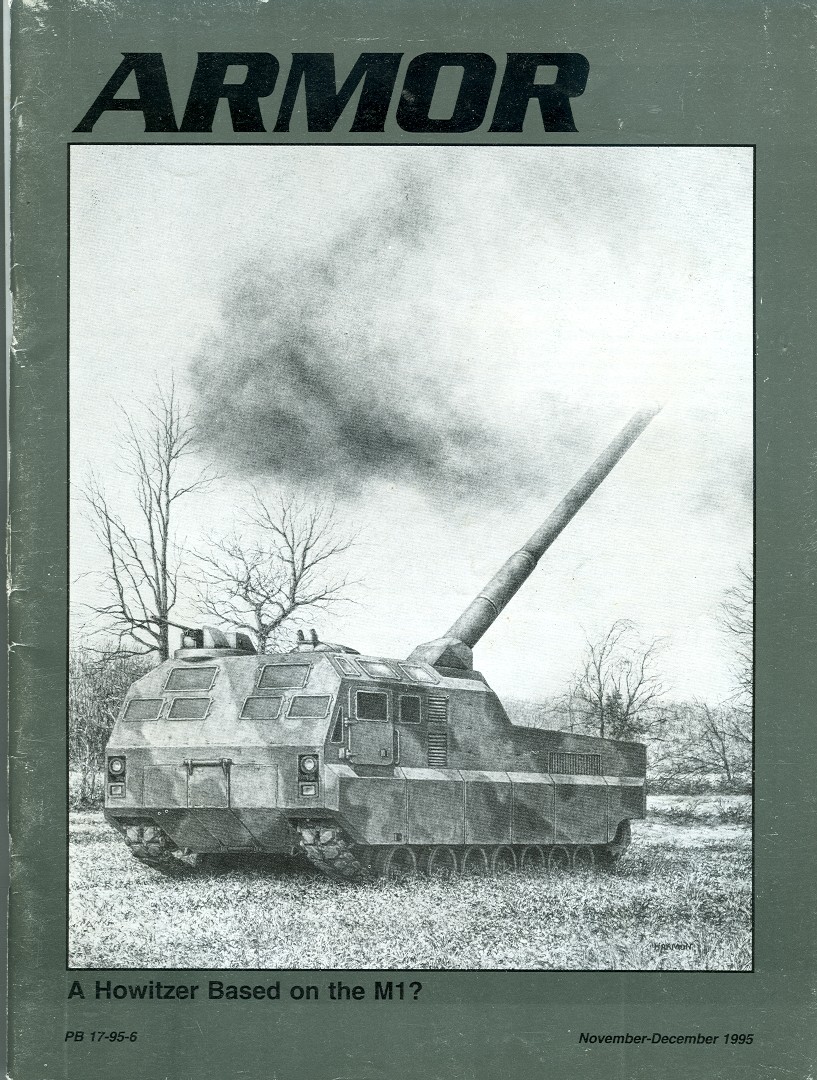
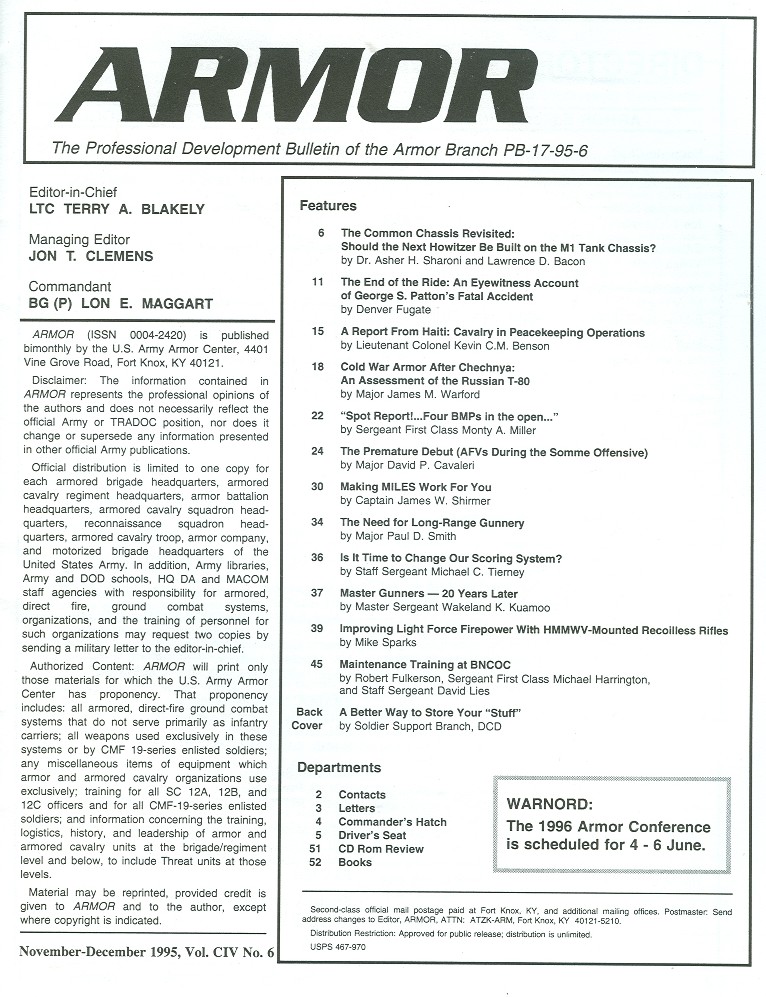
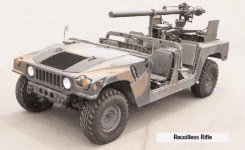

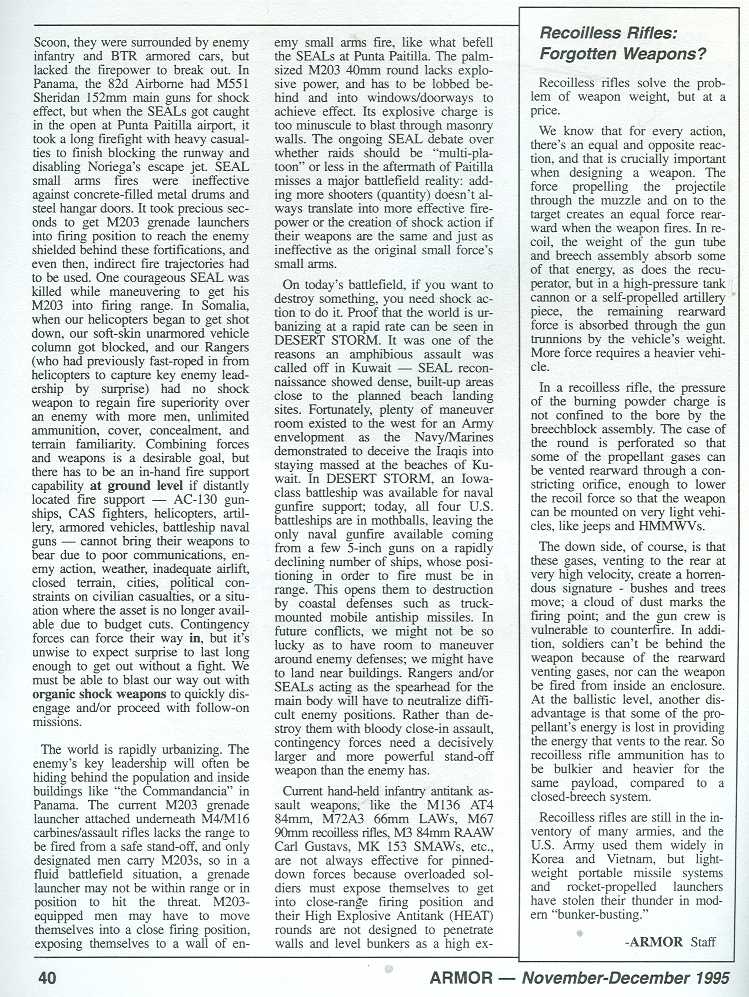
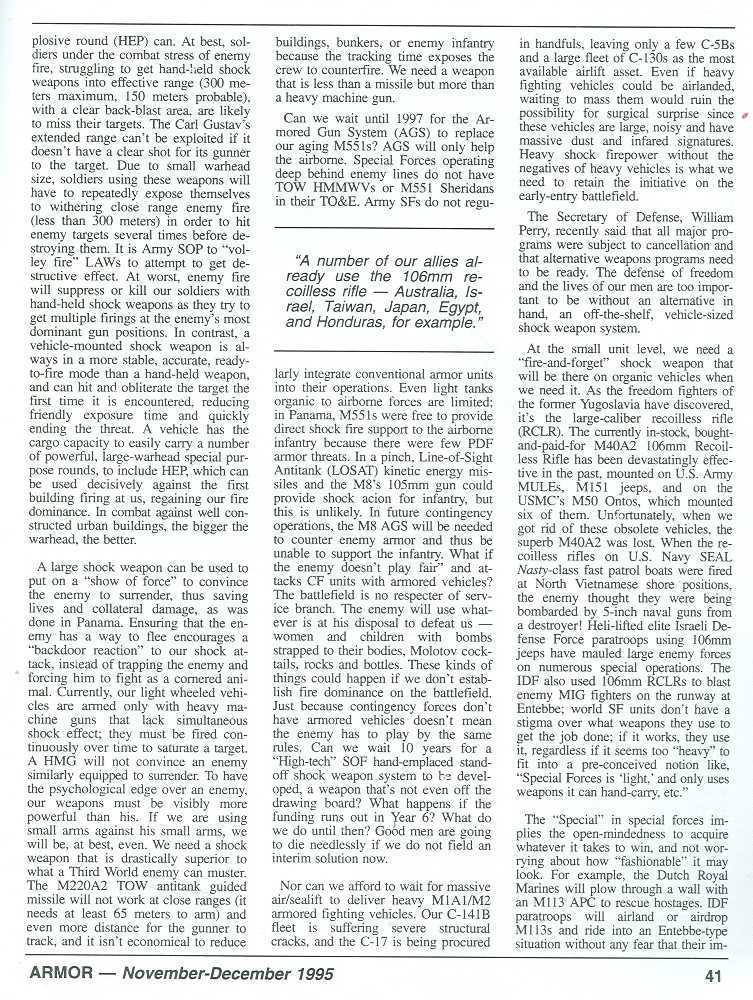
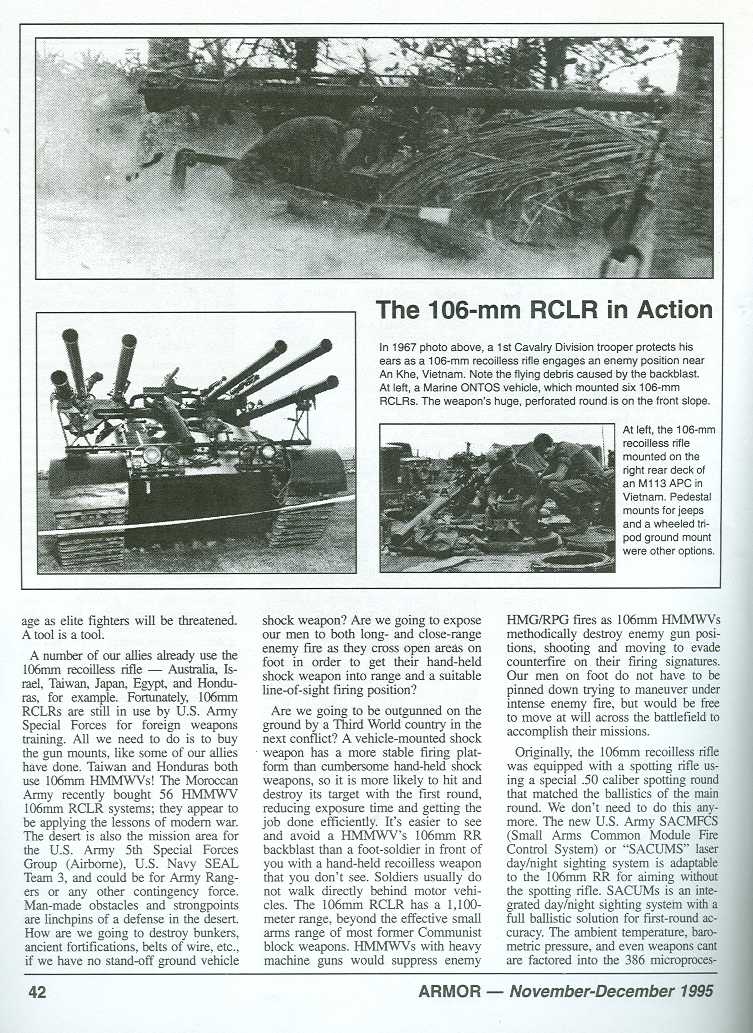
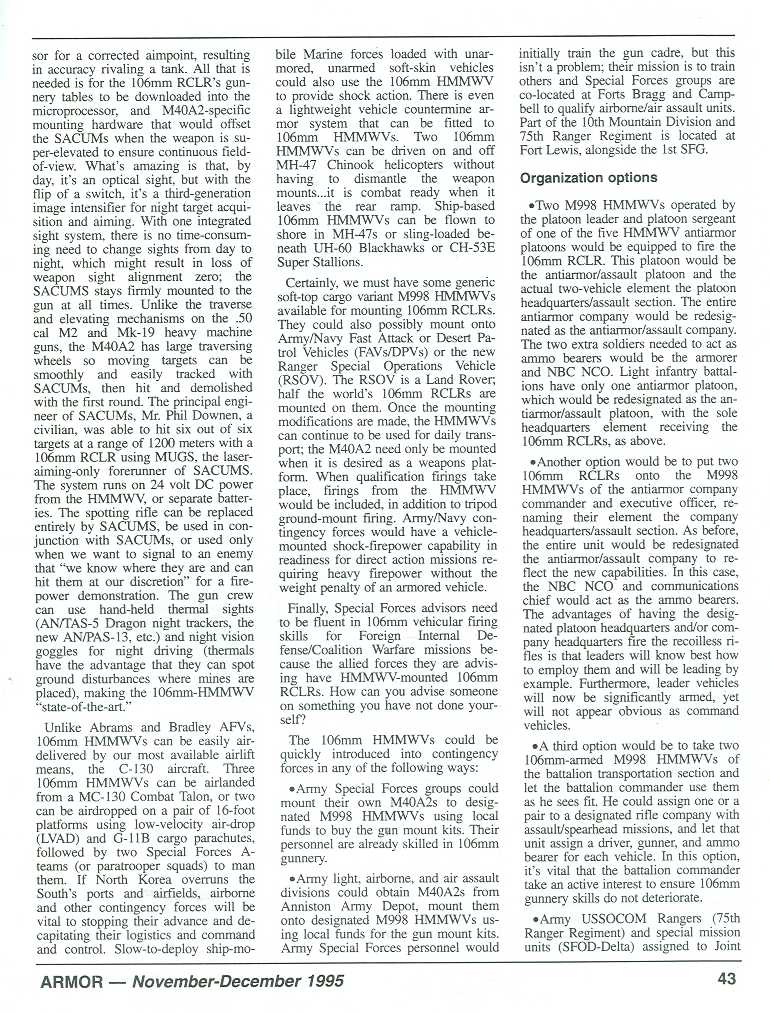

SOF Community--that actually owns 106mm RRs--all they have to do is buy the kits to attach them to their Humvee trucks...they used 106mm RRs on Toyota Land Cruisers in Iraq War 1....
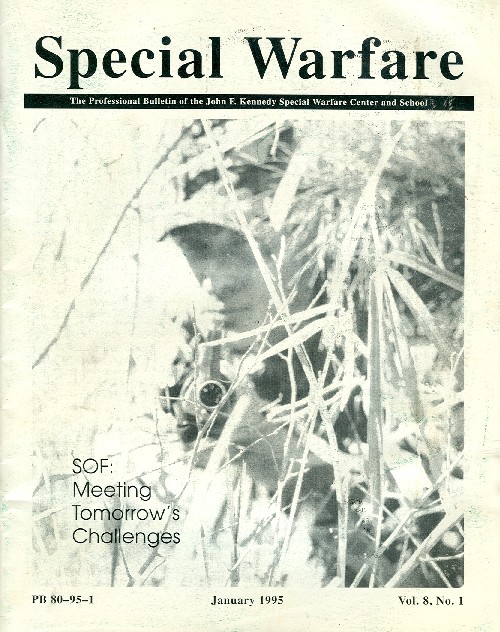
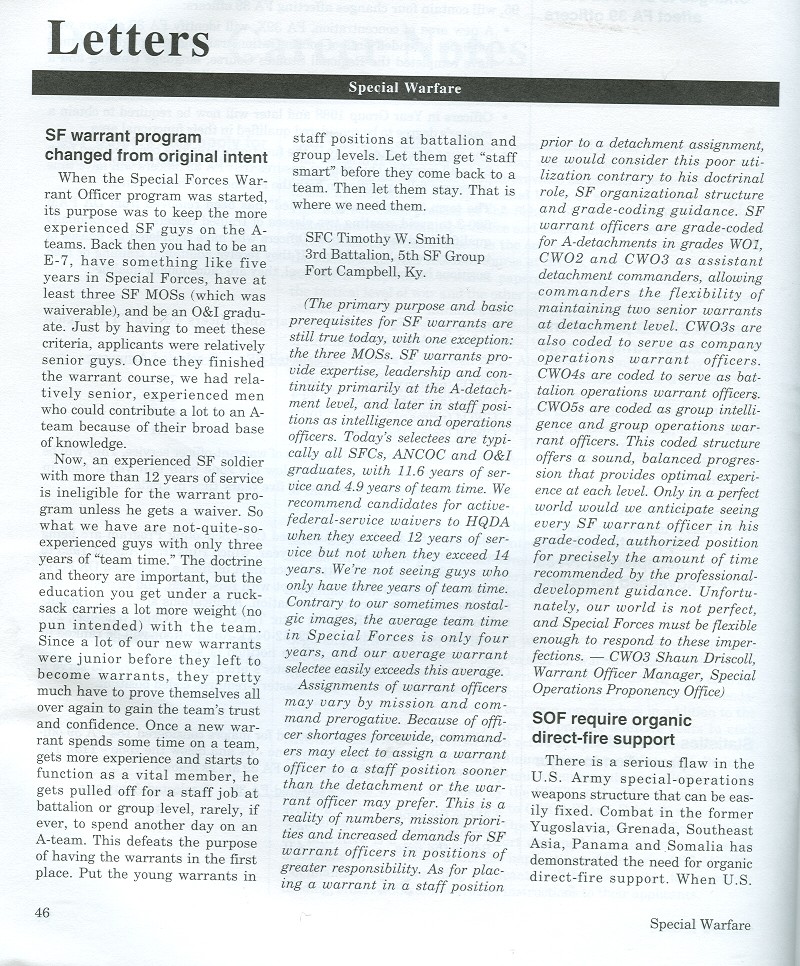
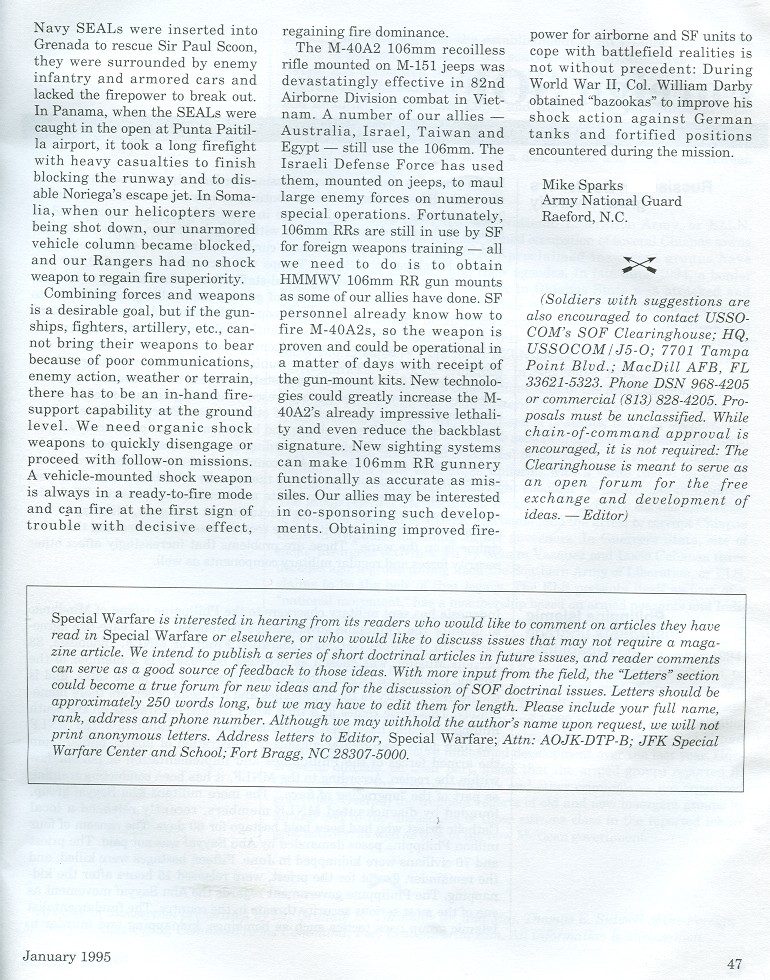
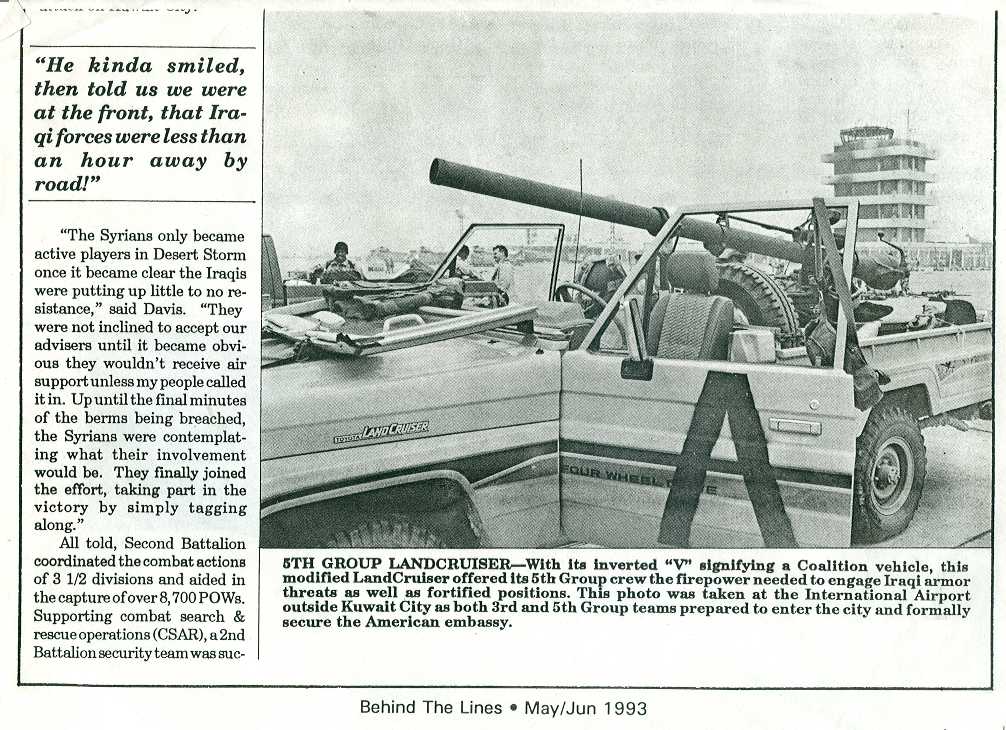
PROOF: Many 106mm RRs in U.S. Storage!

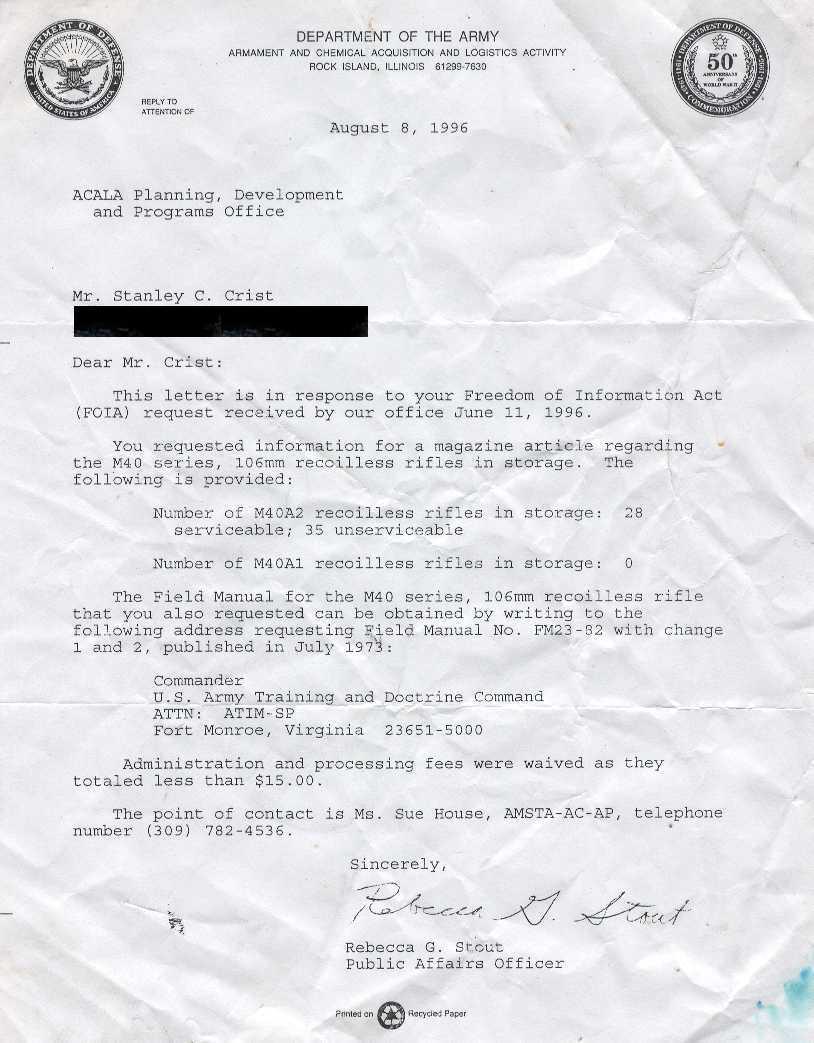
BREAKING NEWS!
As of 2011, U.S. Army National Guard 20th Special Forces Group (Airborne) has decided to do something about thick Afghan mud walls and are seen below shooting the M40 106mm Recoilless Rifle on its tripod ground mount. Better late than, never, huh?
 www.youtube.com/watch?v=JCBMLkgOp0o
www.youtube.com/watch?v=JCBMLkgOp0o
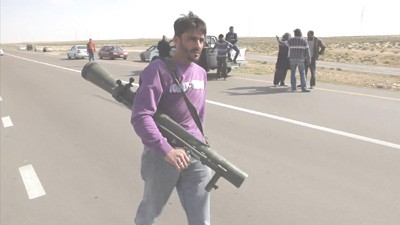
Libyan Rebel with 84mm Carl Gustav: Better Equipped than conventional U.S. Light Infantry! Where'd he get it? Can we get some, too?
www.urbandictionary.com/define.php?term=pwned
pwned
A corruption of the word "Owned." This originated in an online game called Warcraft, where a map designer misspelled "owned." When the computer beat a player, it was supposed to say, so-and-so "has been owned."
Instead, it said, so-and-so "has been pwned."
It basically means "to own" or to be dominated by an opponent or situation, especially by some god-like or computer-like force. "Man, I rock at my job, but I still got a bad evaluation. I was pwned."
OR
"That team totally pwned us."
If this wasn't startling enough to pwn internet idiots who drool at places like TANKEYNET, the rebels in Libya are using 84mm and 106mm RRs to bombard the G-man.

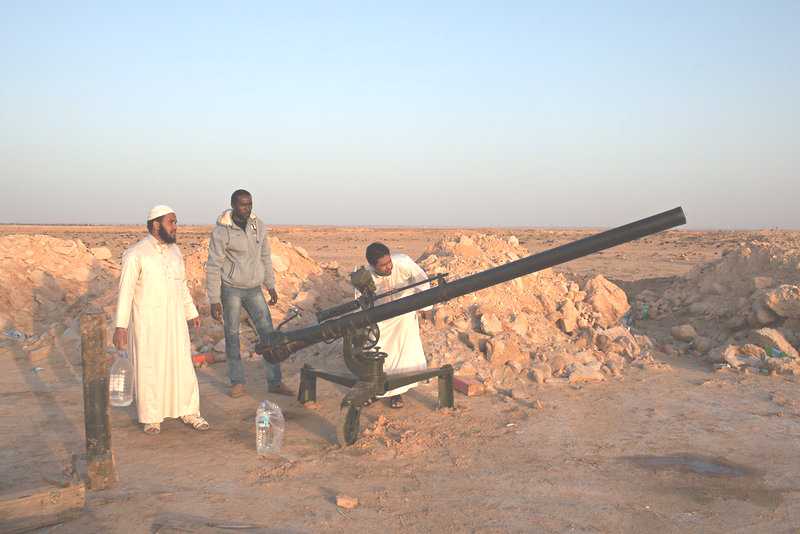
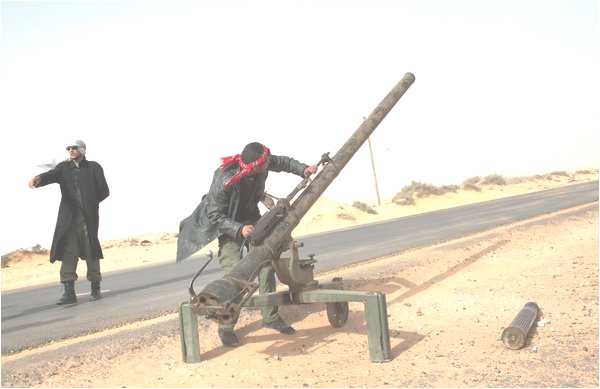
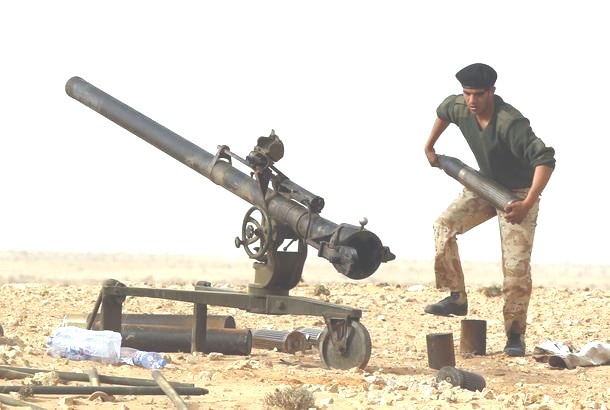
Maybe we should go to Libya so we can get some decent HE bunker-busting RRs since the U.S. military bureaucracy doesn't want to supply us with them so we can WIN?
Infantry Community: owns the ideal 106mm RR Mounting Vehicles: M113 Gavins

 www.youtube.com/watch?v=xZE1ZOMTGmI
www.youtube.com/watch?v=xZE1ZOMTGmI
We could mount them using the $6900 kit available from AM General that installs within hours to any generic soft-top M998 HMMWV 4x4 vehicle. Honduras, Taiwan and Morocco have HMMWV-106mm RRs. The 106mm RR will mount on the new diesel John Deere Para-Gator 2x4 vehicle like the old M274 MULE did, but with better off-road performance; and it will fit into the tiny multi-BILLION$$ dollar CV-22 Osprey. Mount a dozen 106mm RRs on Para-Gators or designated HMMWVs in an Airborne Infantry Battalion's Anti-Armor Company, redesignated: "Anti-Armor-Assault" Company. The German 3-ton Wiesel tracked, armored fighting vehicle is an even better choice for helicopter-borne units like the 101st Air Assault Division at Fort Campbell, Kentucky since it can also fit INSIDE CH-47D Chinooks. The U.S. Army owns 6 Wiesels for R & D work.
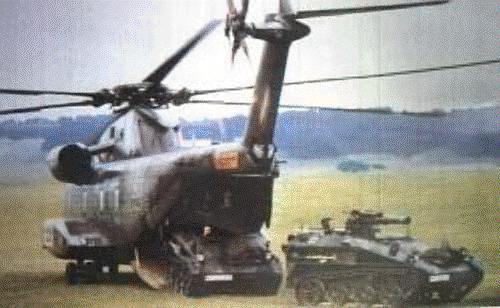
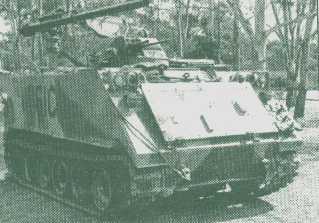
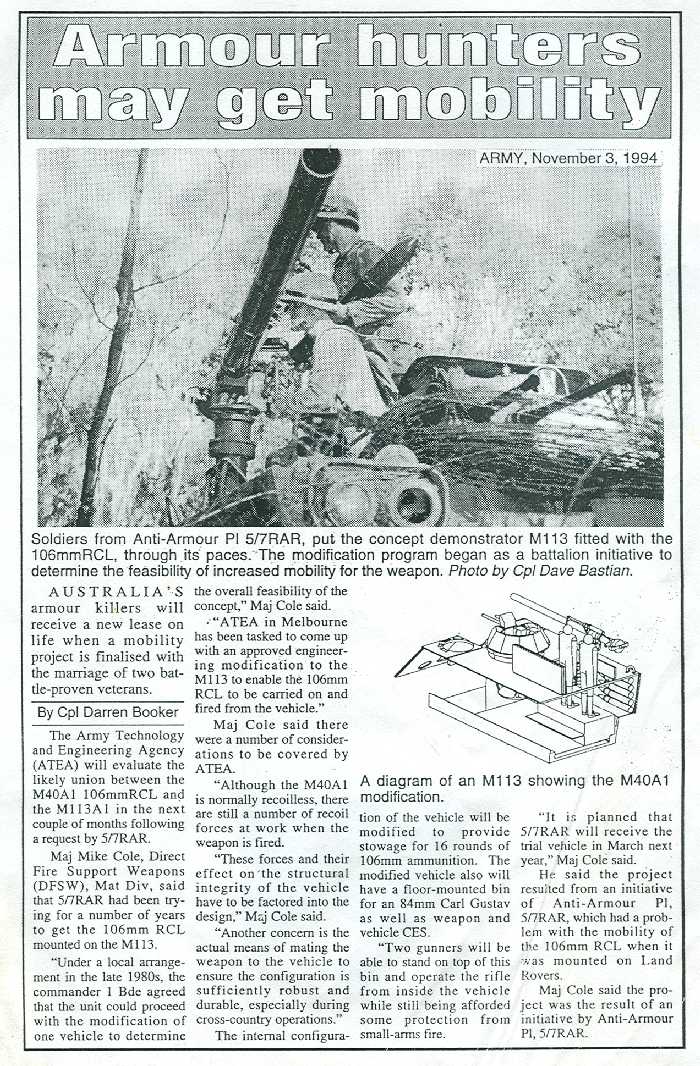
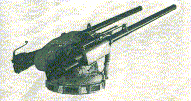
There are myriad mounting options of 106mm RRs to M113A3s; the dual 106mm RR TC turret that keeps the gunner under armor protection is available from CETME in Spain. The TC-7/106 turret means only one crew member has to briefly expose his upper body to reload the weapons. The gunner aims the rifles within the vehicle with the reloading carried out through the troop hatch. Both traverse and elevation are hydraulic with the gunner's handle having fast target search at 15 degrees a second. The turret also has a .50 caliber Heavy Machine Gun and the .50 cal spotting rifle on the right hand RR.
Empressa Nacional Santa Barbera
Julian Camarillo 3
28037 Madird, Spain
Telephone: (91) 585-0100 Telex: 44466 ENSB E Fax: (91) 585-0268
Pakistan has a twin 106mm RR mount on their M113s with a laser range-finder that extends effective range out to 1500 meters using old ammunition. POF, Wah Cantonnement, Pakistan Telex: 5840 POPAC PK. Maybe we can have Pakistan and Spain fight with us the next time there is a war?
These are all fine options, too.... LETS JUST DO IT.
SIDEBAR: Airborne 106mm Recoilless Rifles
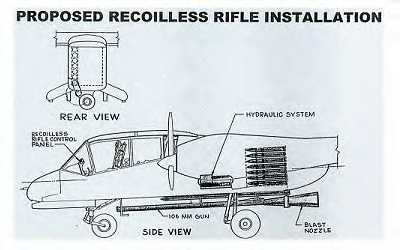
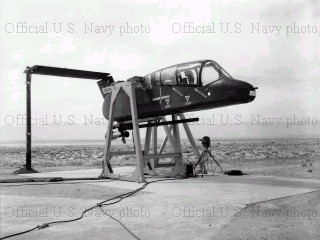
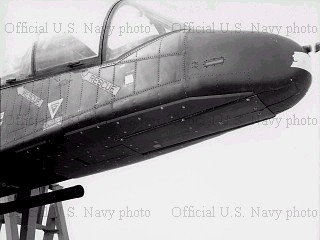

In WW2, Piper Cub "Grasshoppers" had 2.36" "Bazooka" recoilless rocket launchers fitted under their wings and successfully killed a few German tanks. The idea of a ground-mobile, "grasshopper" observation/attack plane that could be co-located with a ground maneuver unit like the field artillery and not only radio back firing coordinates but attack targets itself with its own on-board weaponry is an important capability we had in WW2/Korea but lack in today's ego-driven U.S. military.
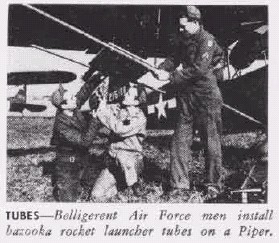
Legendary USMC Colonel K.P. Rice and Beckett saw the need for this type of "Maneuver Air Support" (MAS) in 1960 and pushed for the aircraft we know today as the OV-10 Bronco. One of the things he wanted was a multiple-shot 106mm RR for his OV-10. Here is what his web site reports:
www.volanteaircraft.com/ov-10-3.htm
"When we looked into the possibility of using ground type ordnance we found that there were aviation type fuses that were perfectly compatible with both 81mm and 4.2in mortar rounds. Thus, if we wanted a lot of small "bombs," we could use mortar rounds to provide illumination, white phosphorus attack or screening, or high explosive. Our favorite, essentially 'ideal' ground weapon for our airplane was the 106mm recoilless rifle. This weapon was a lot more accurate that the equivalent aerial weapon, the five inch rocket, and a single round only weighed 40lbs as opposed to about 100lbs for a rocket. The problem was that the 106 was a single shot weapon and we wanted more shots.
At this time I was also the Small Airfield for Tactical Support (SATS) project officer for a desert test at Twenty-Nine Palms. In this capacity I often visited Harvey Aluminum, the company that made the new matting for our runways and taxiways. Harvey also had an exceptional R&D organization which had developed a variety of interesting products from rocket implanted earth anchors, to advanced fuses and even the first aluminum beer cans. On one visit I happened to mention something about the desirability of an automatic recoilless rifle. They immediately showed me two working prototypes and introduced me to Dr. Musser who had patented the first recoilless rifles during WWII. This put the recoilless rifle back in the concept more strongly than ever. We even took one of the prototypes to Camp Pendleton where the marines demonstrated it to a group of scientists from China Lake. It worked beautifully and was very impressive. Dr Musser indicated that with a modest change to the nozzle, the weapon could be made suitable for operations from a twin-boom aircraft like the one we proposed.
...In '69, I left North American to join KP at China Lake where he headed a new group pushing advanced aircraft systems. Mixed in with a number of missile, weapon and aircraft projects we tried again to get the recoilless rifle airborne. At the time, Piper was pushing a modified P-51 for roles similar to the OV-10. Their "Enforcer" modification had a much more powerful (and lighter) turboprop engine, lots of armor and impressive speed and maneuverability. A retired Air Force colonel who knew KP was heading the project and had also become a believer in the recoilless rifle. It was through this program that we finally got a recoilless rifle fired from an aircraft.
In the event, an Army P-51, supported for maintenance and parts by the Air Force, was flown from a naval base (China Lake) by a marine pilot for the demonstration. The recoilless rifles were unmodified infantry weapons and were mounted on the wingtips to obviate any problems with back-blast. The test went off rather well, and, although not a test of accuracy, the pilot, Maj. Pippa, reported that the rounds went right where they were pointed.
Unfortunately, the people selling the Enforcer not only bucked Air Force policy, they also infuriated some of the top brass with their sales tactics. This resulted in letters from the Chief of Staff, USAF to the Chief of Naval Operations and then down the chain of command to the CO of the Naval Weapons Center, China Lake, to the effect that no more tests, or even mention of this aircraft would be tolerated. That was the end of the Enforcer.
In spite of this, we did, finally, get a feasibility test of the recoilless rifle on the OV-10. A standard, unmodified infantry type recoilless rifle was mounted on the centerline of an OV-10A. The OV-10 was then hoisted into the air by a crane and the rifle fired remotely. The gun fired appropriately, but the back-blast and shock wave from the unmodified nozzle slightly damaged the rudder trim tabs. I considered this quite a success considering the fact that a modified nozzle, like that suggested by Dr. Musser, together with the flight speed of the aircraft would take care of the problem on any production installation. Even without these obvious modifications, a slight beef-up of the trim tabs would have taken care of the problem. Nonetheless, the damaged trim tabs were used as a basis for ending all further tests."
FEEDBACK!
E-mail 1st TSG (A) itsg@hotmail.com
A field grade officer writes:
"106mm RR a superb weapon. Spoke with SF captain in my group who is at SOCOM at Bragg. The SF still play with 106mm because it's part of their global mission if they go to a country to support because that's all the AT power that poor 3rd world country can afford -unlike us, with our wunderwaffe Drag it, Dragon M47 piece of crap. This captain also is articulate about it and the demise of the AGS."
Notice that the Army corporate "borg" doesn't change regardless of the facts on the ground, unless a general officer gets an "epiphany" the rest of us are supposed to suffer with immoral and incompetent BS.
"Your page is intriguing. I'm worried that the wrong lessons might be learned from the Afghanistan fighting, with many forgetting that our role in it was only part...and that the proxy forces were not just air-supported."
Our reply:
The U.S. military is in love with air strike firepower for BOMBARDMENT not firepower for MANEUVER. By relying on the Air Force for firepower via a computer mouse-click, some in the Army think we can get away with a thin-skin armored car with a machine gun and not have to fire & maneuver. That America's enemies have escaped this firepower (Iraq, Serbs, Taliban/Al Queda) because we did not have adequate maneuver to block and encircle them has not registered in the minds of our leaders who want to wage quasi-war at maximum cost and minimum political risk.
GO TO POP GUNS 2: OTHER GROUND FORCE OPTIONS
Private Murphy's View
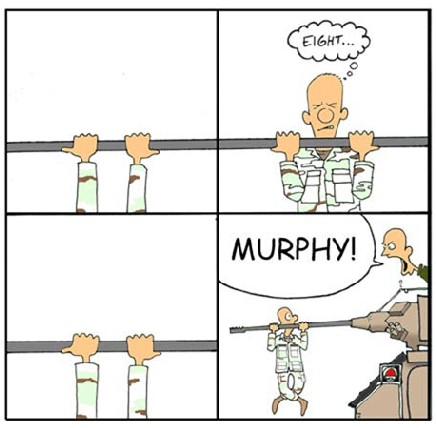
 On your desk?
On your desk?
 RETURN TO AES HOME PAGE
RETURN TO AES HOME PAGE
